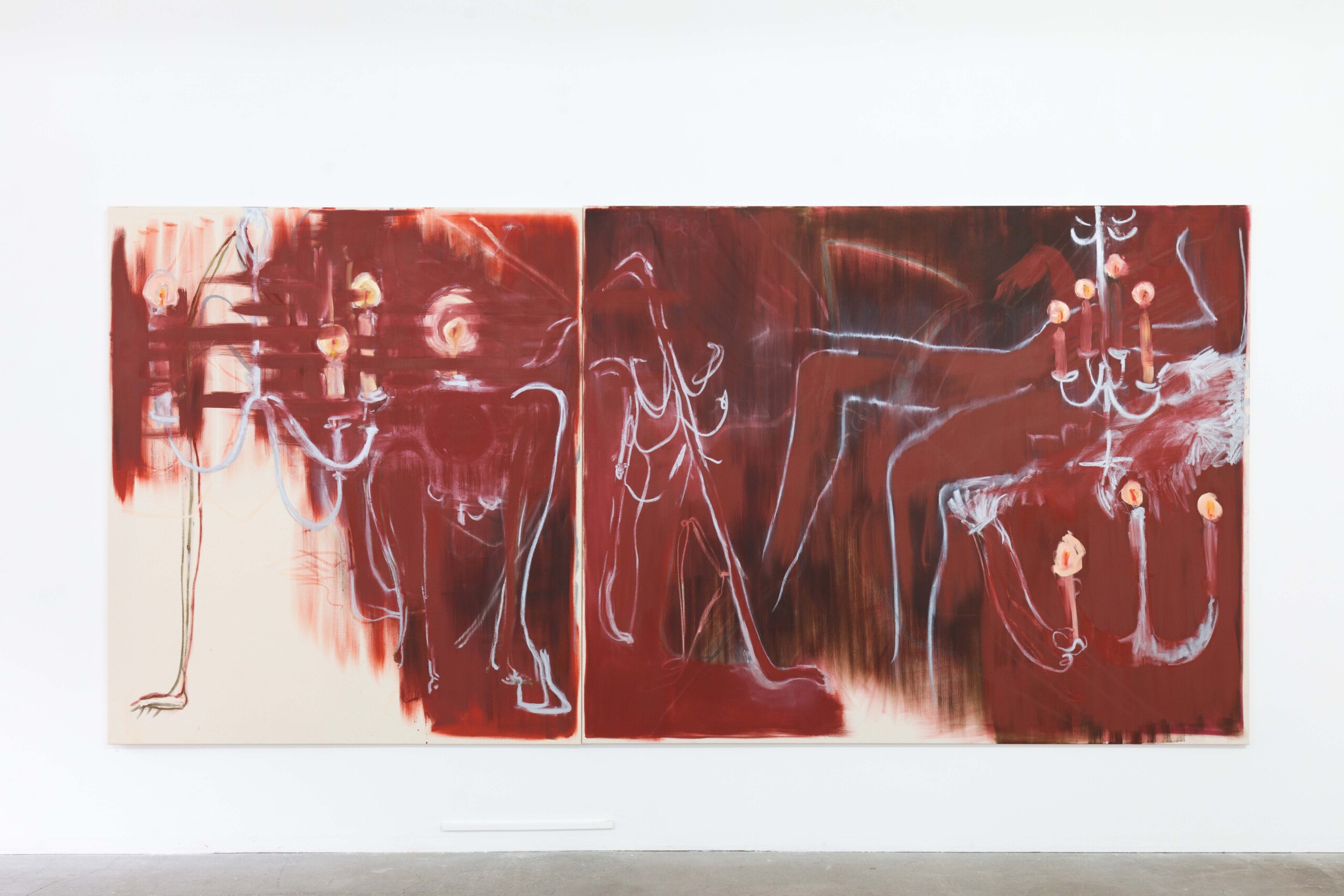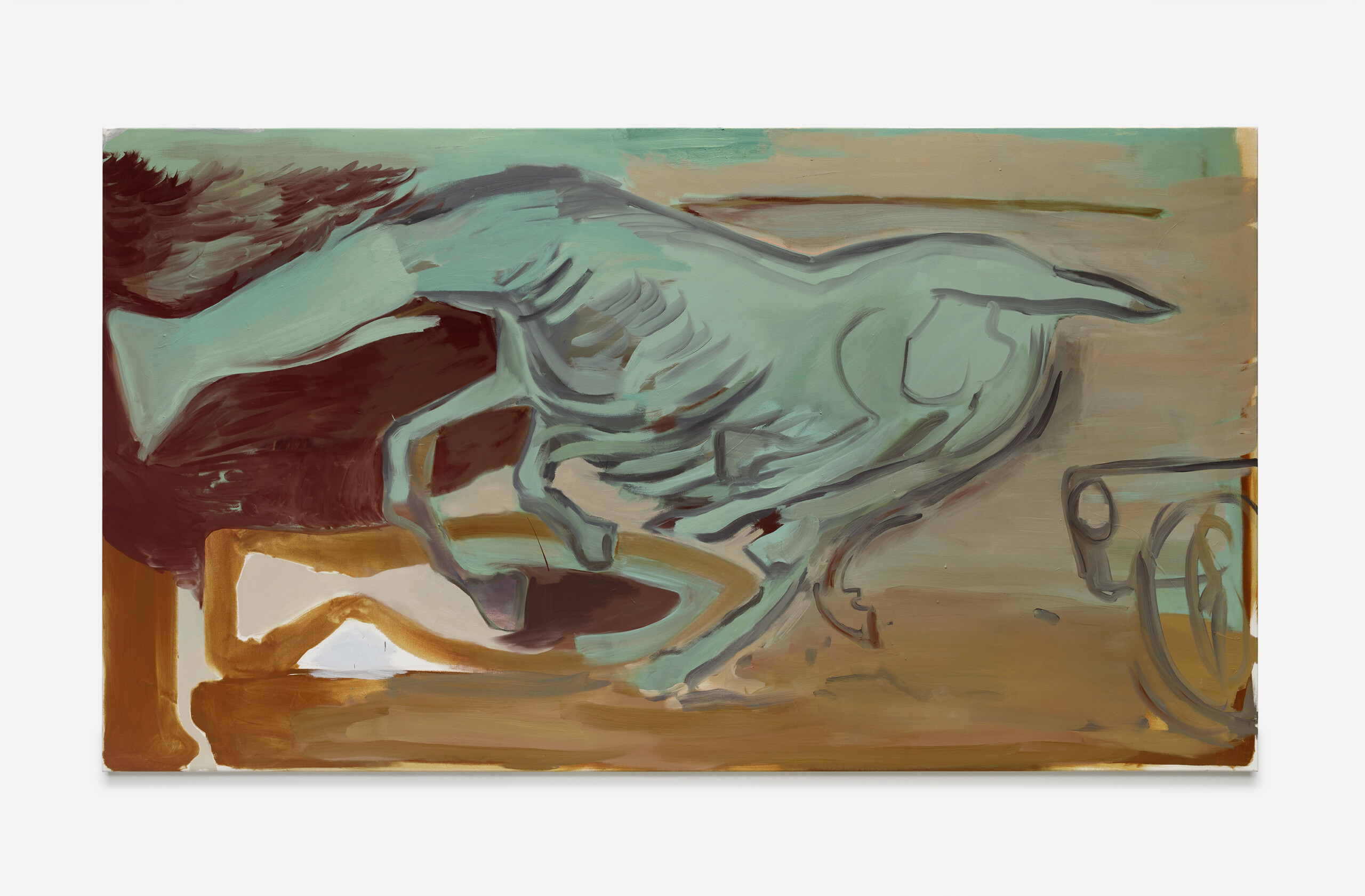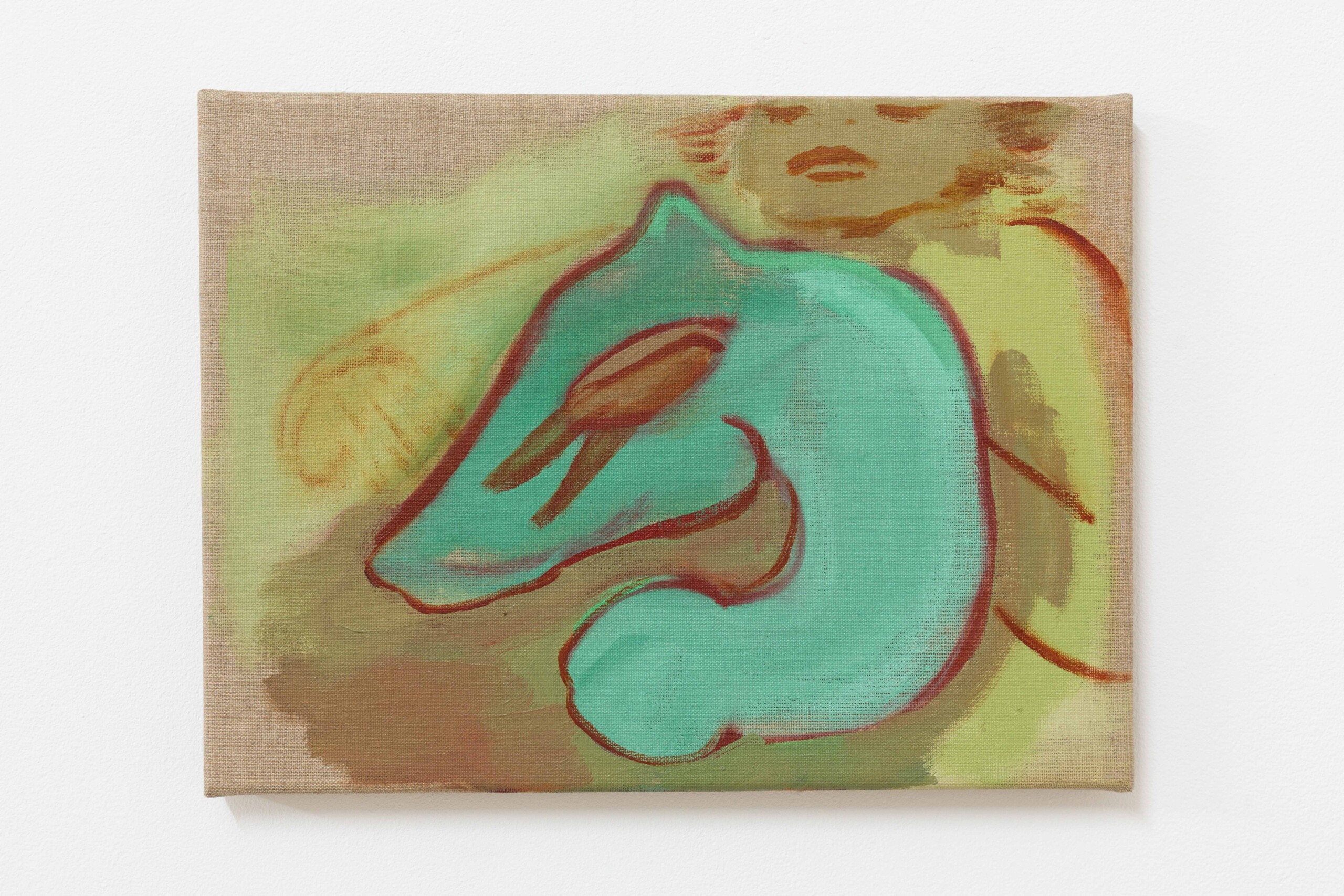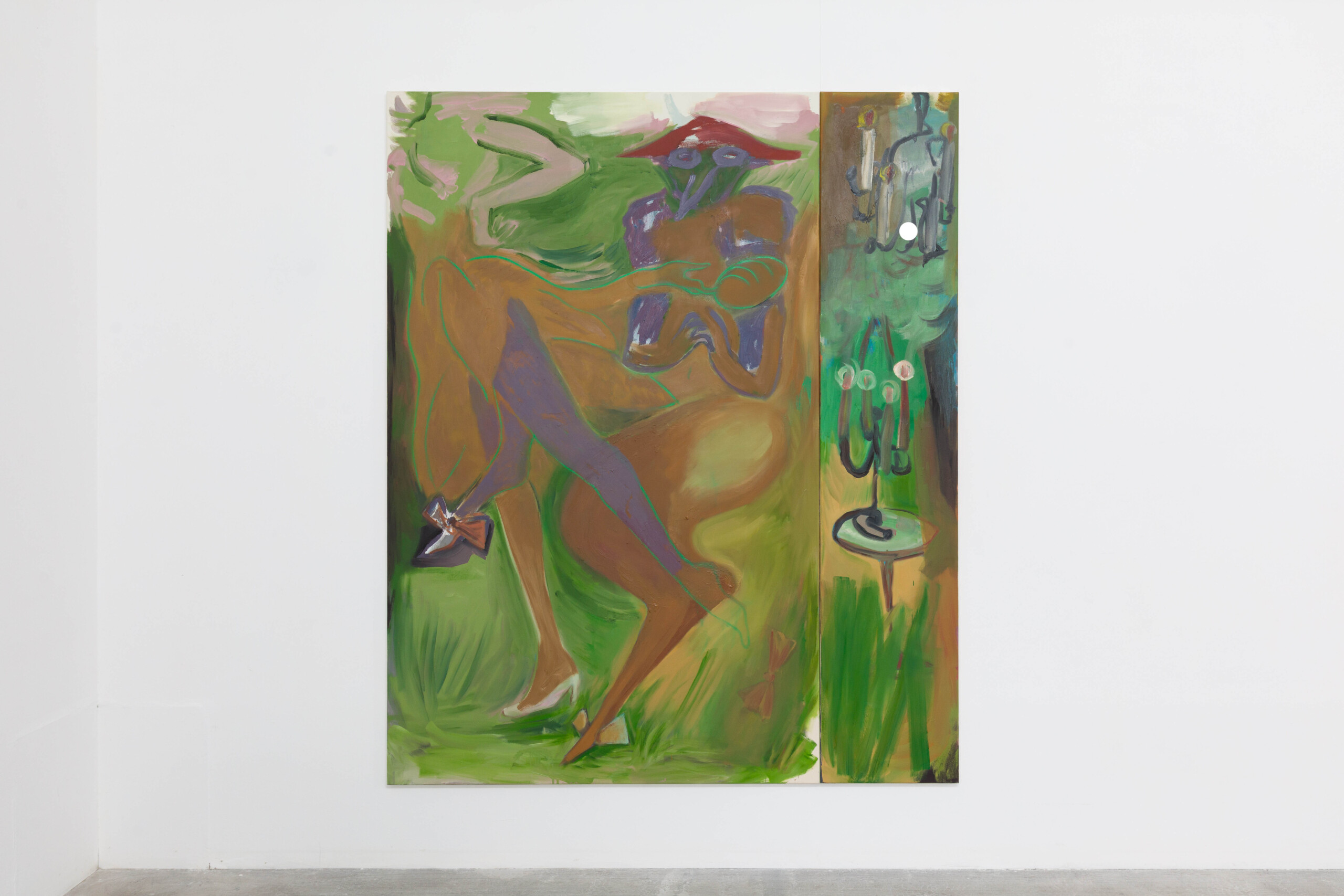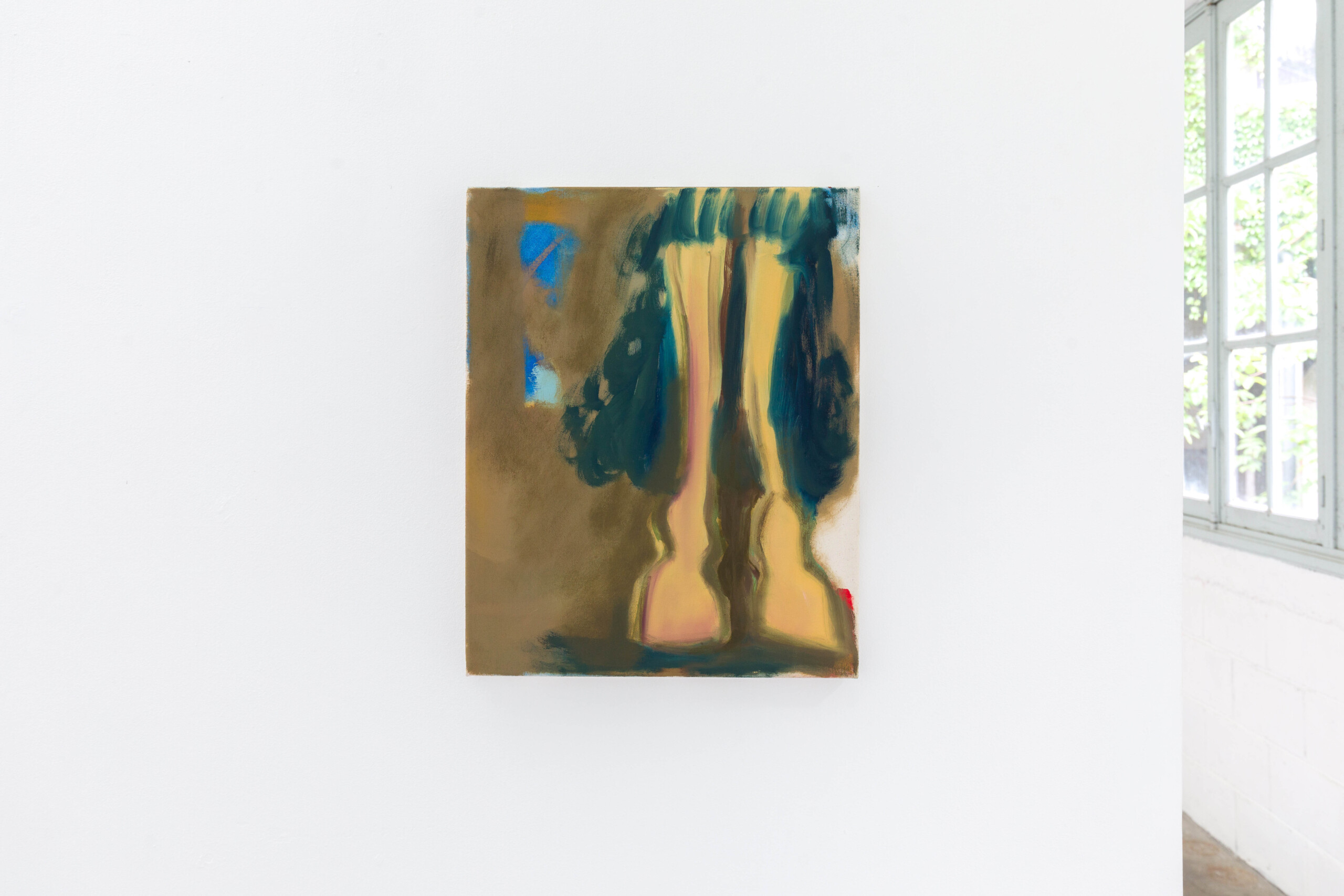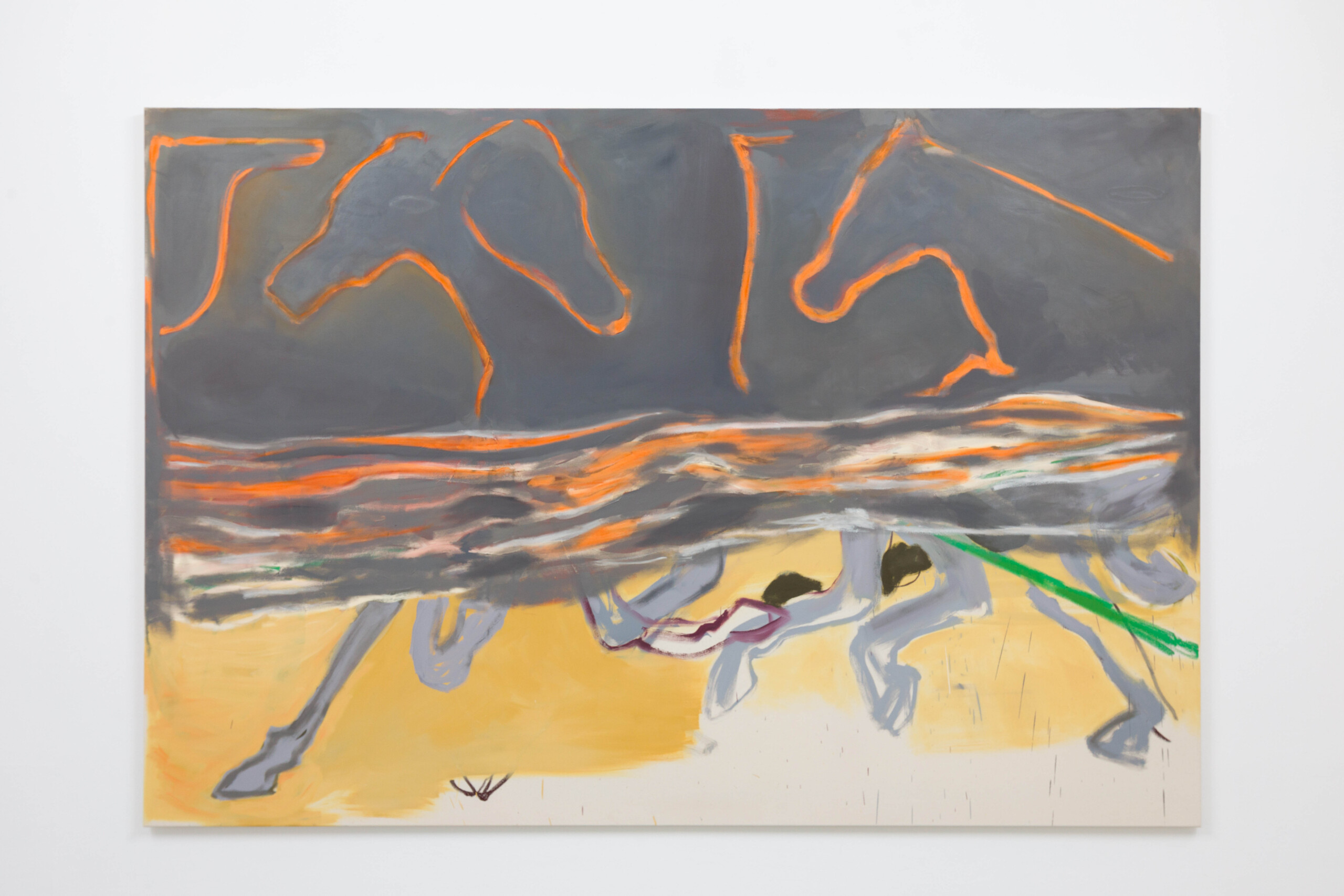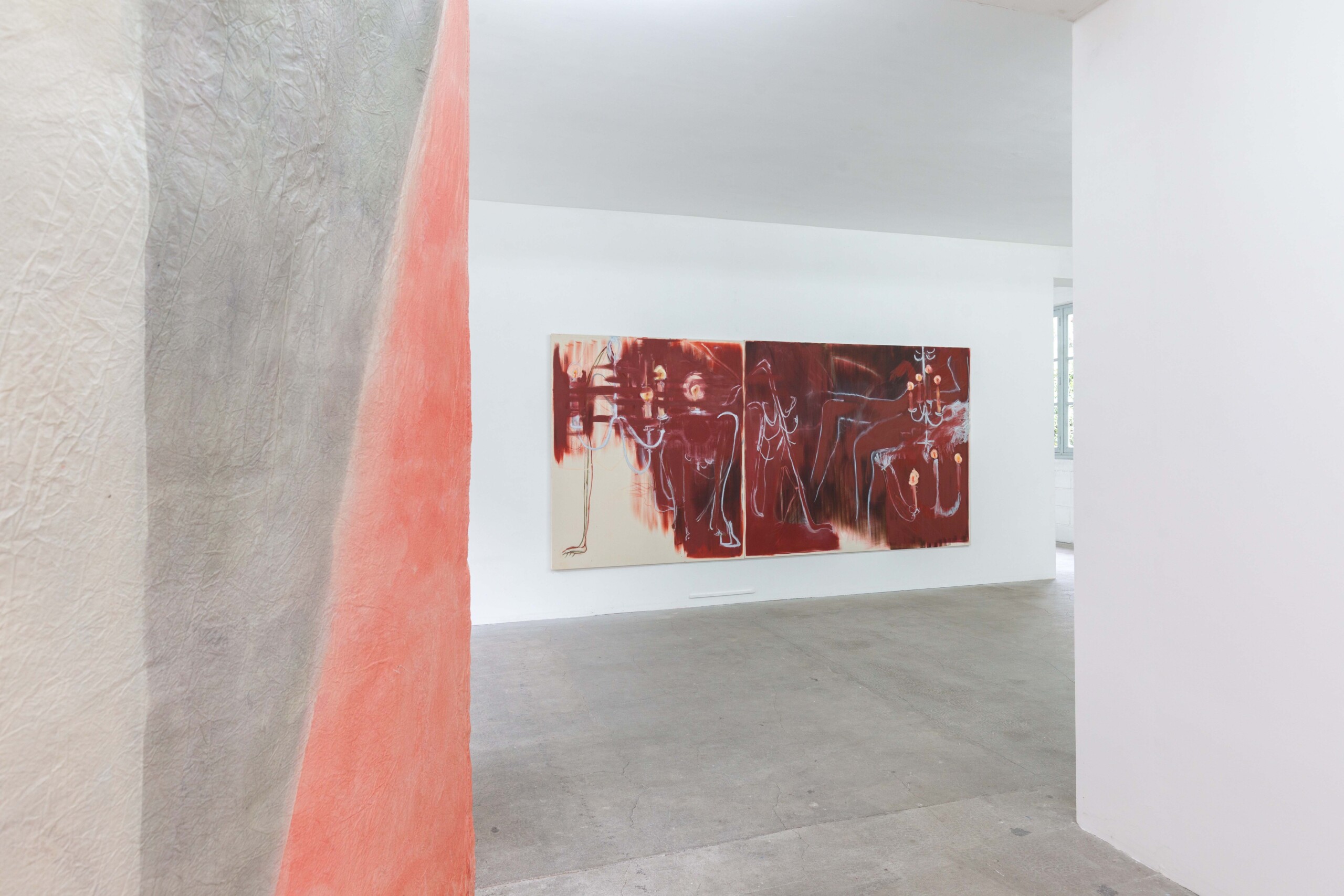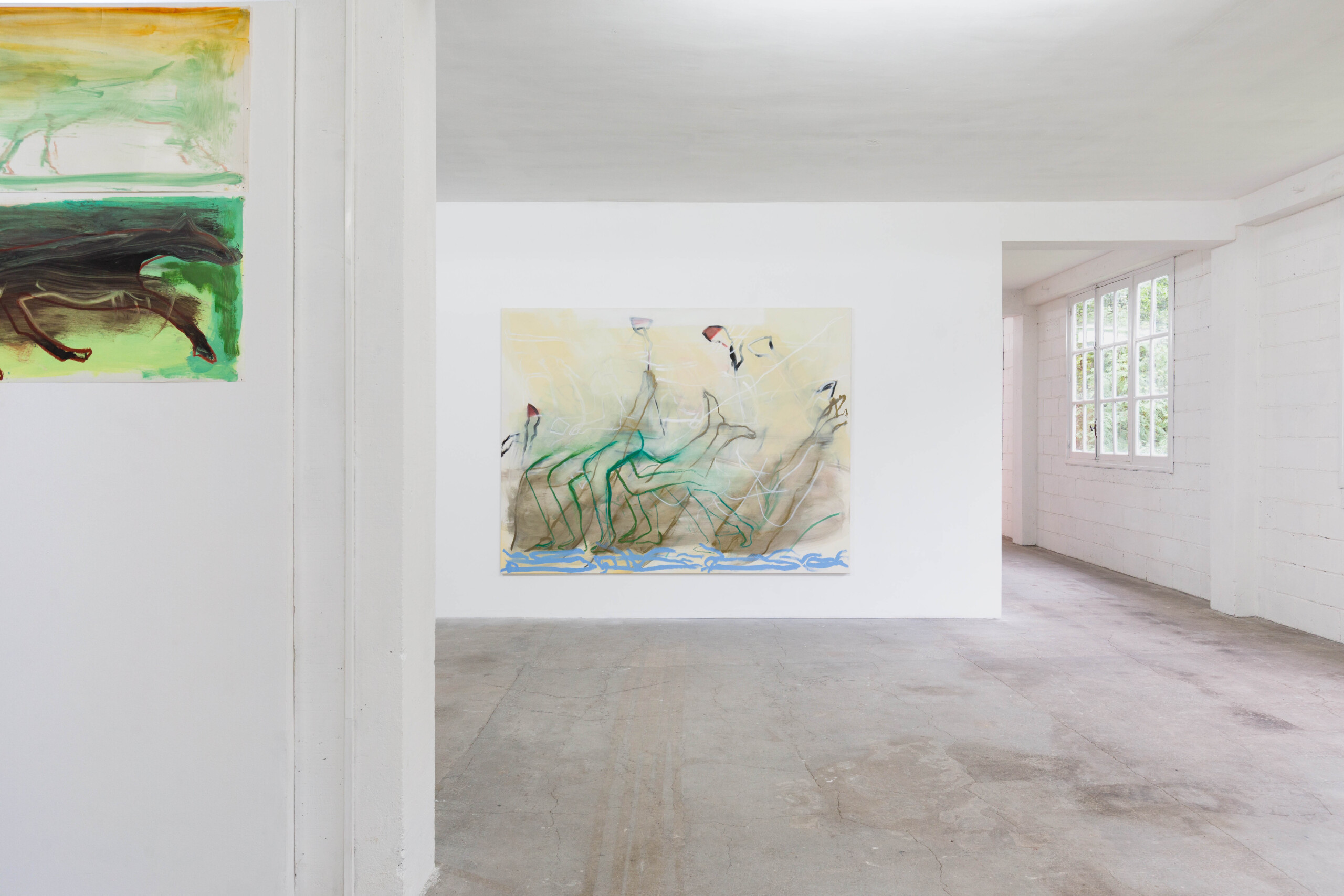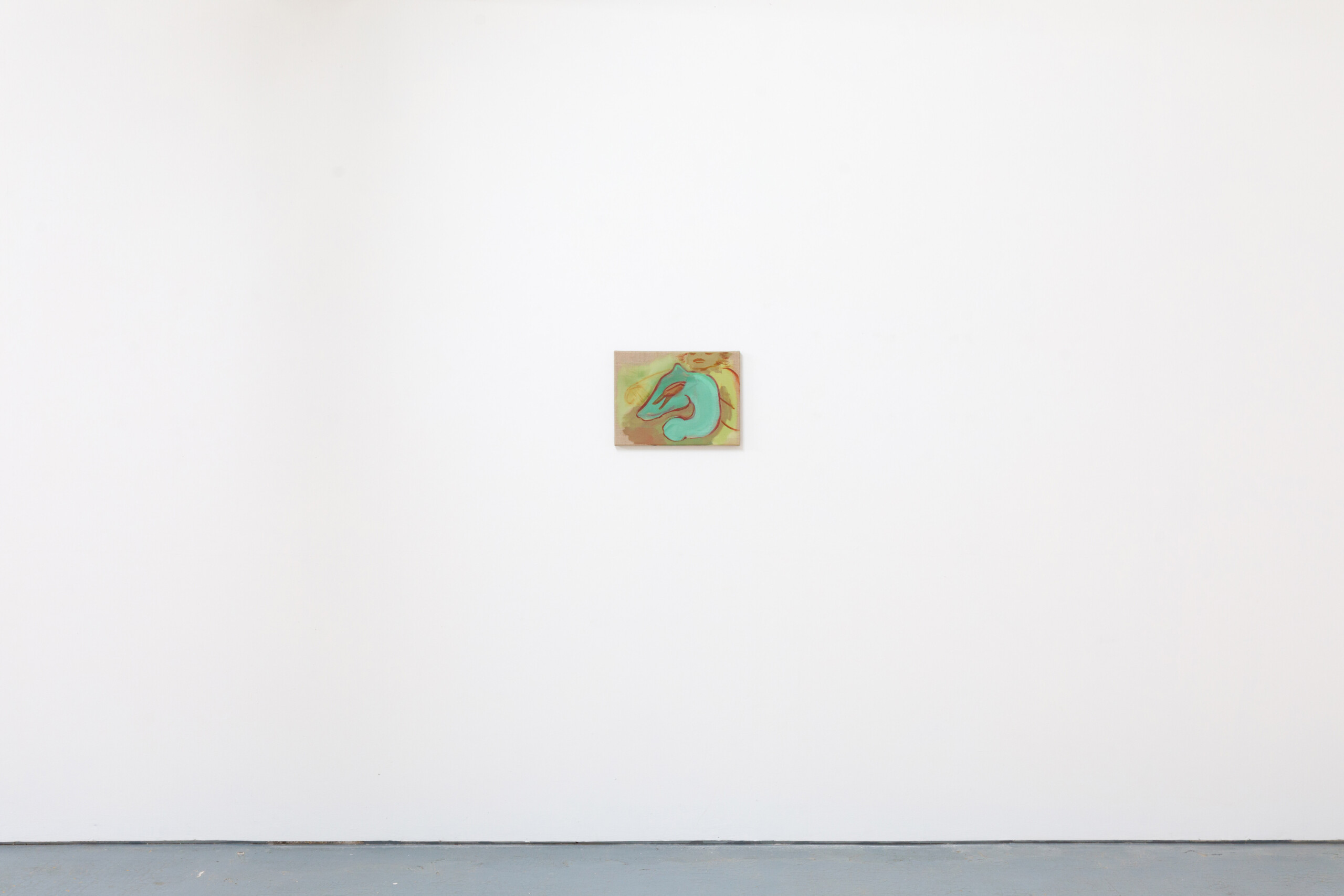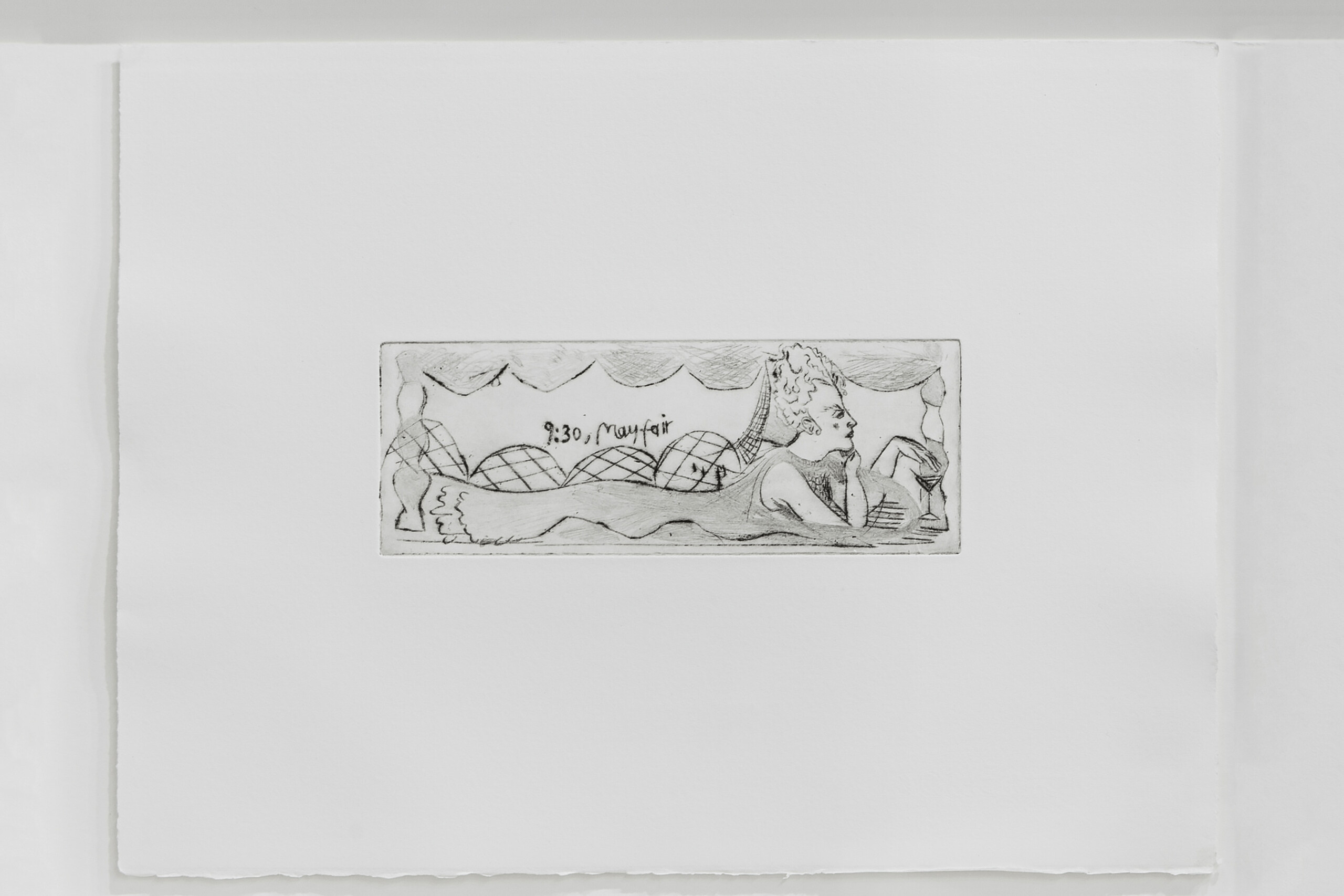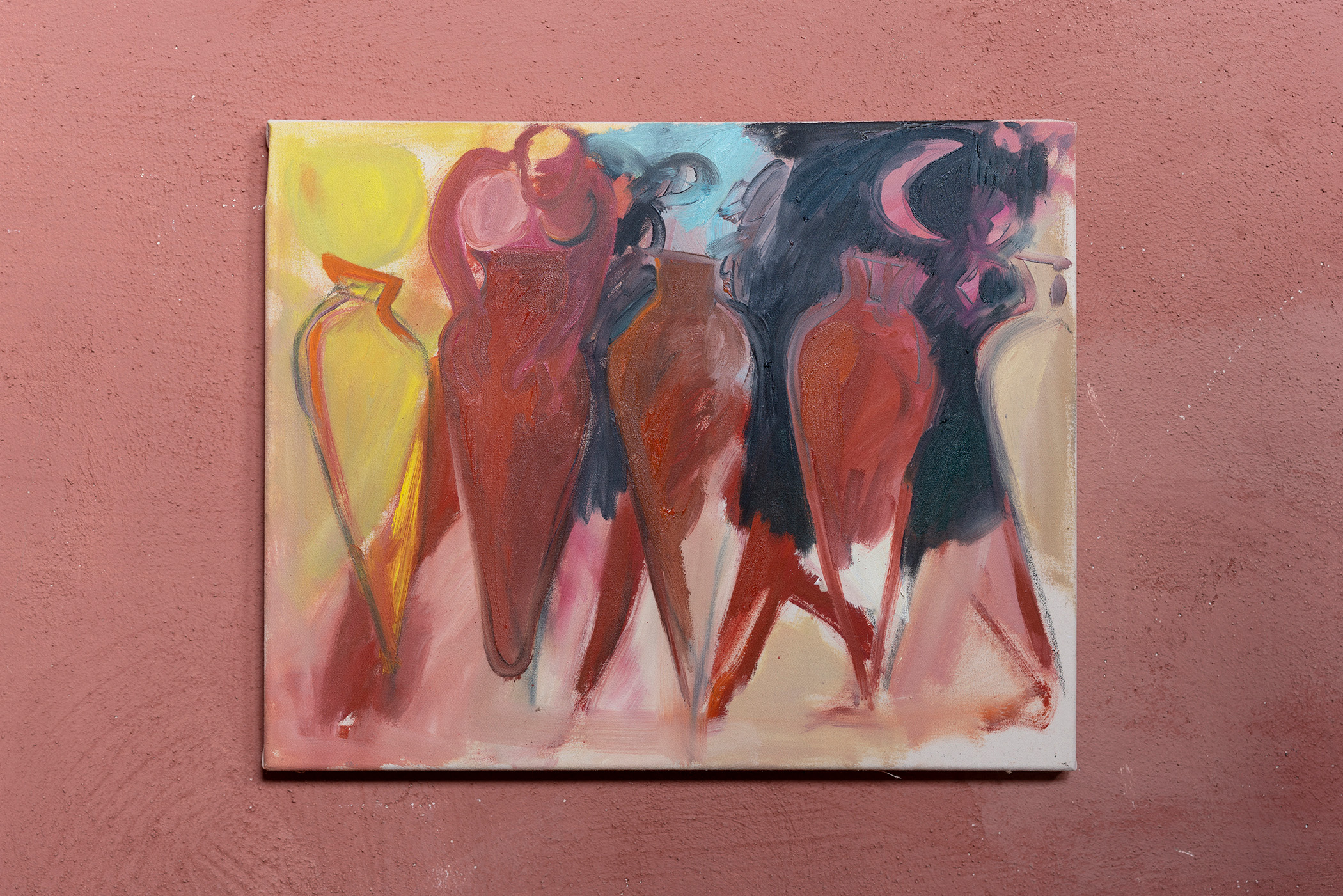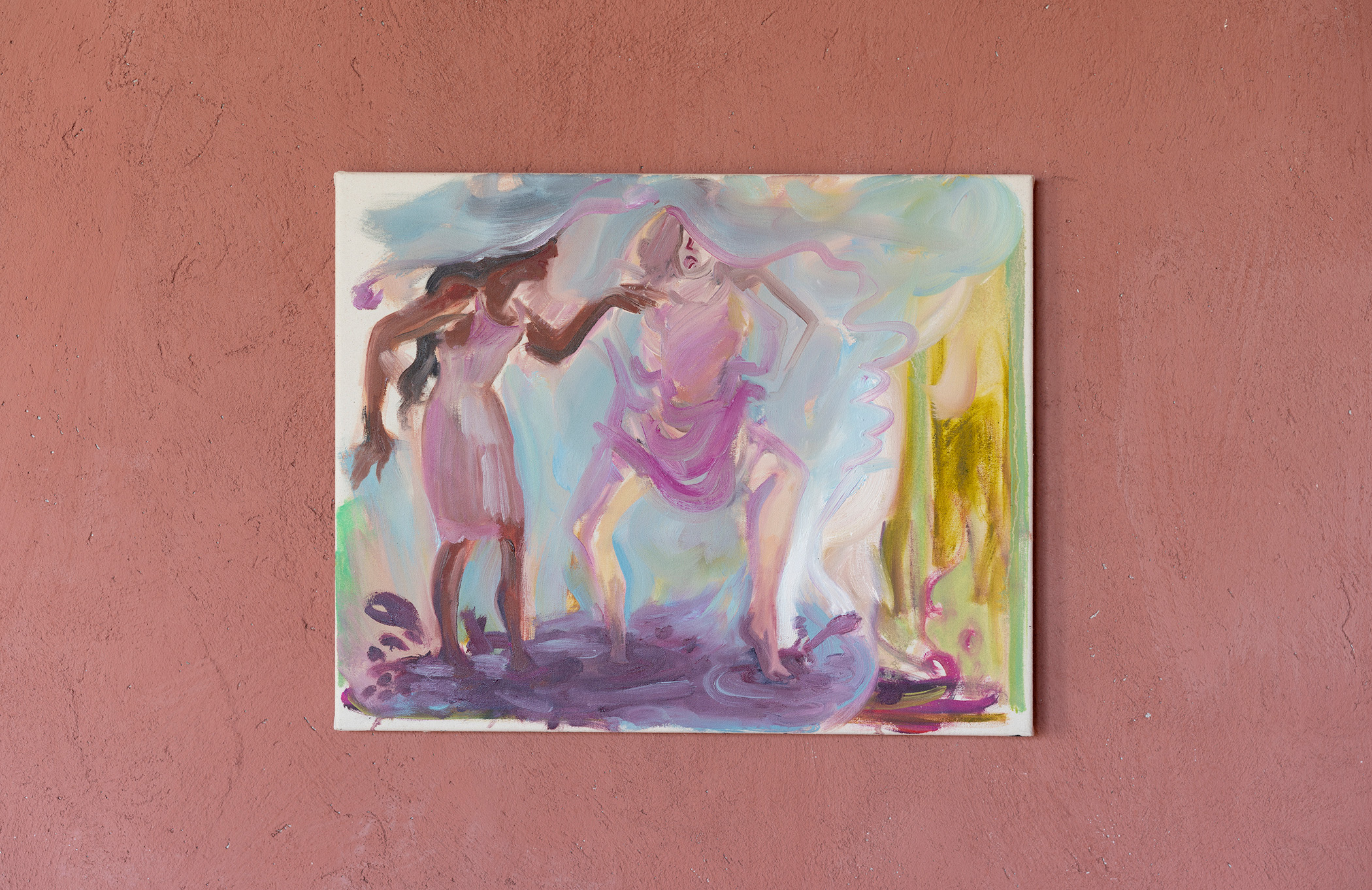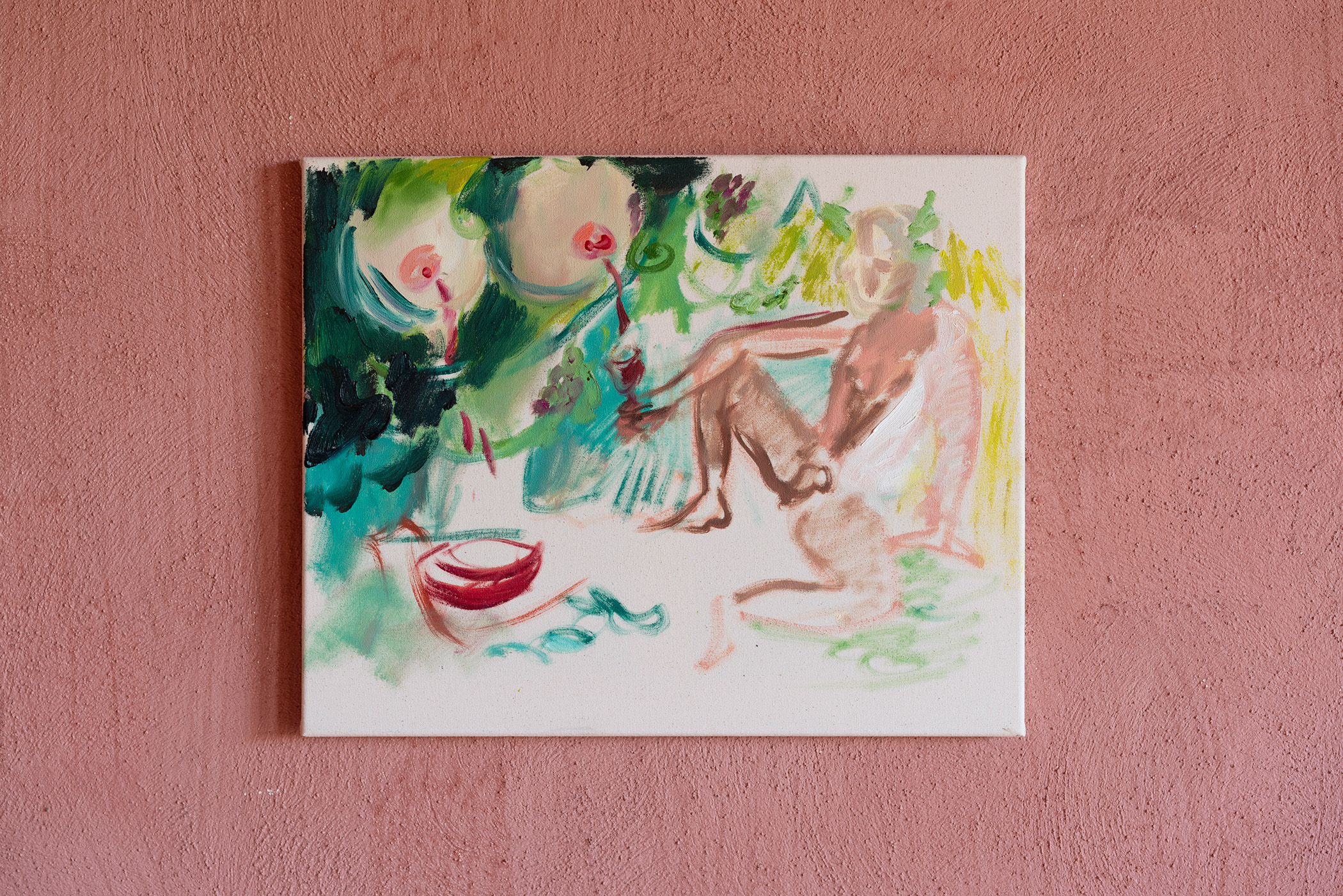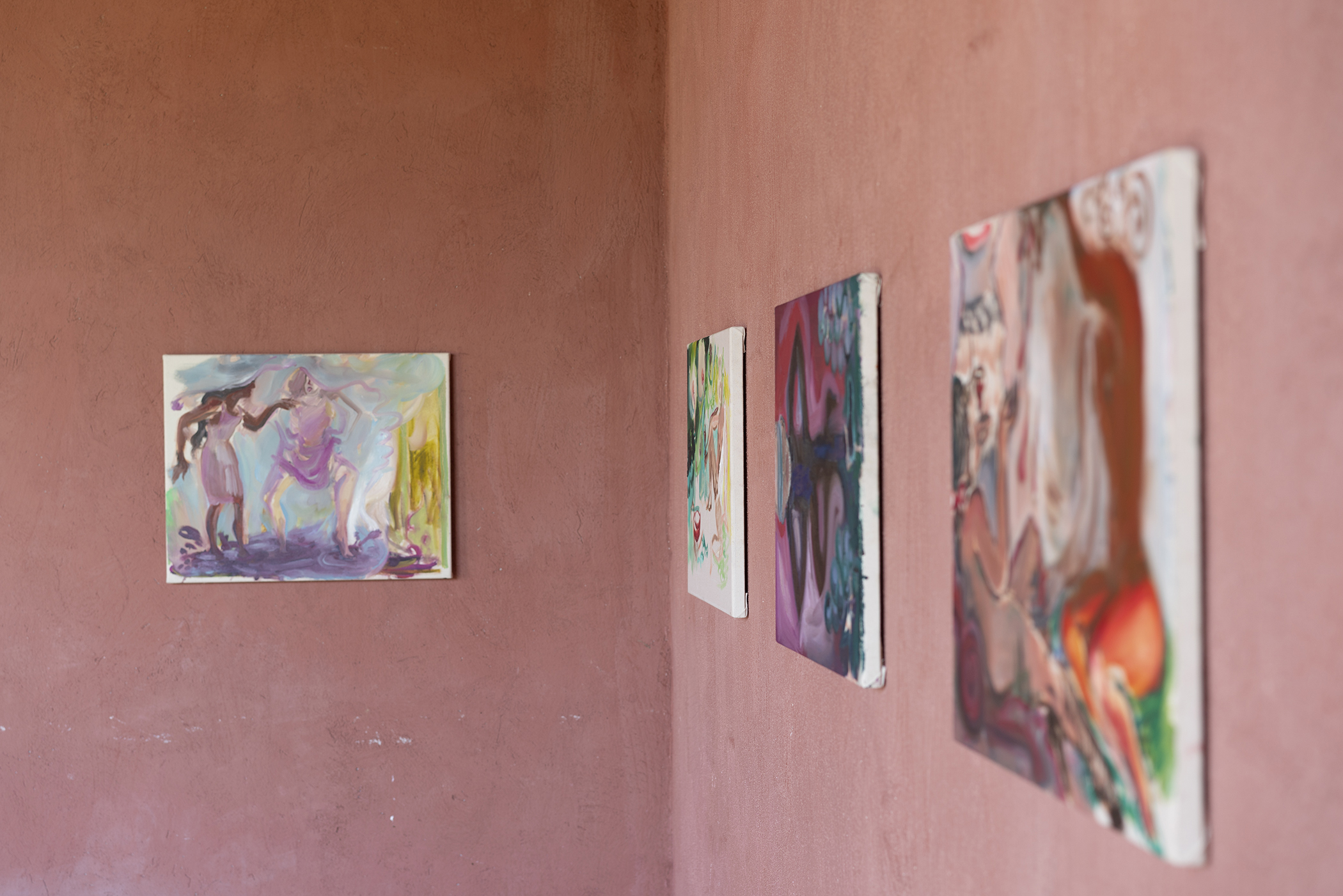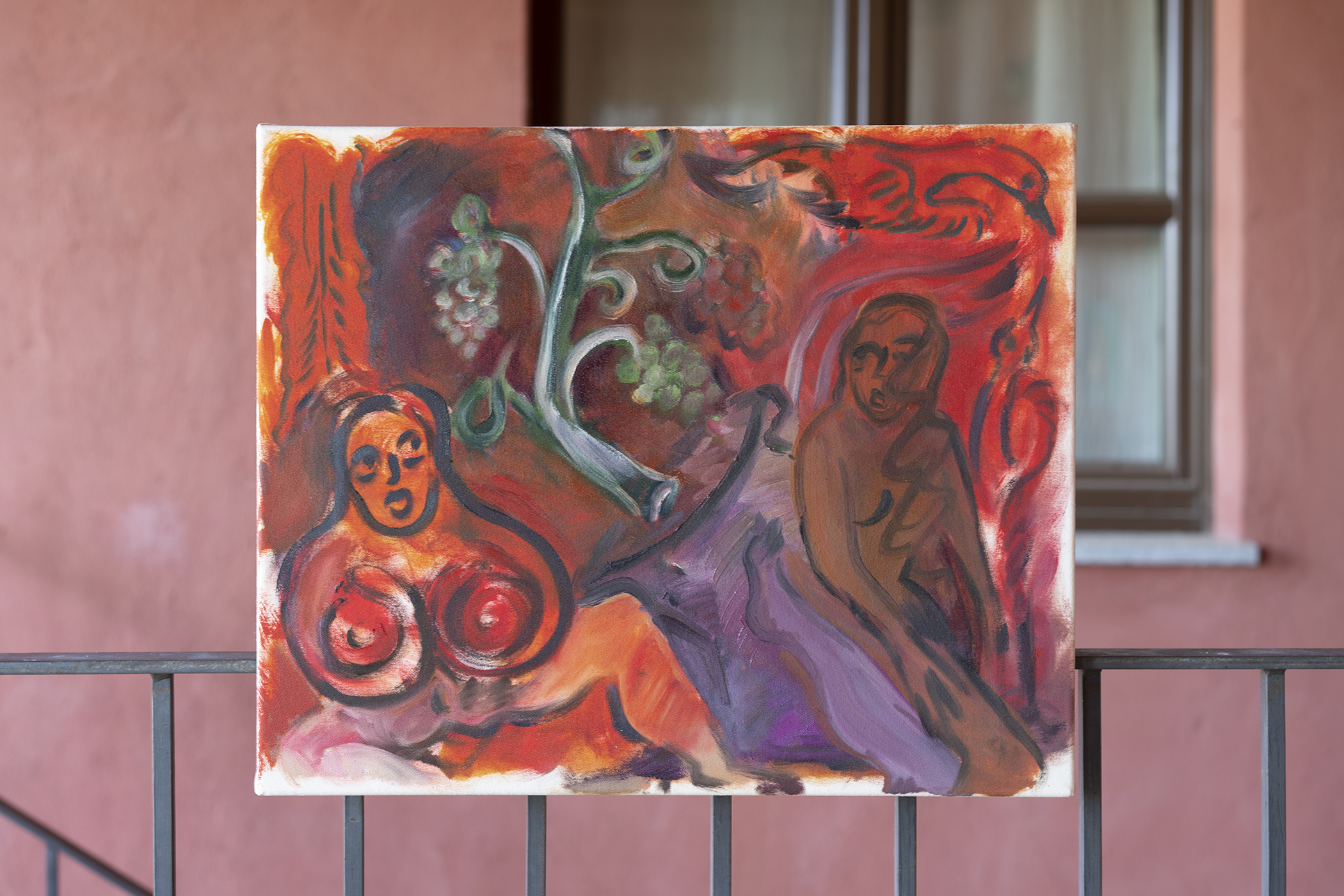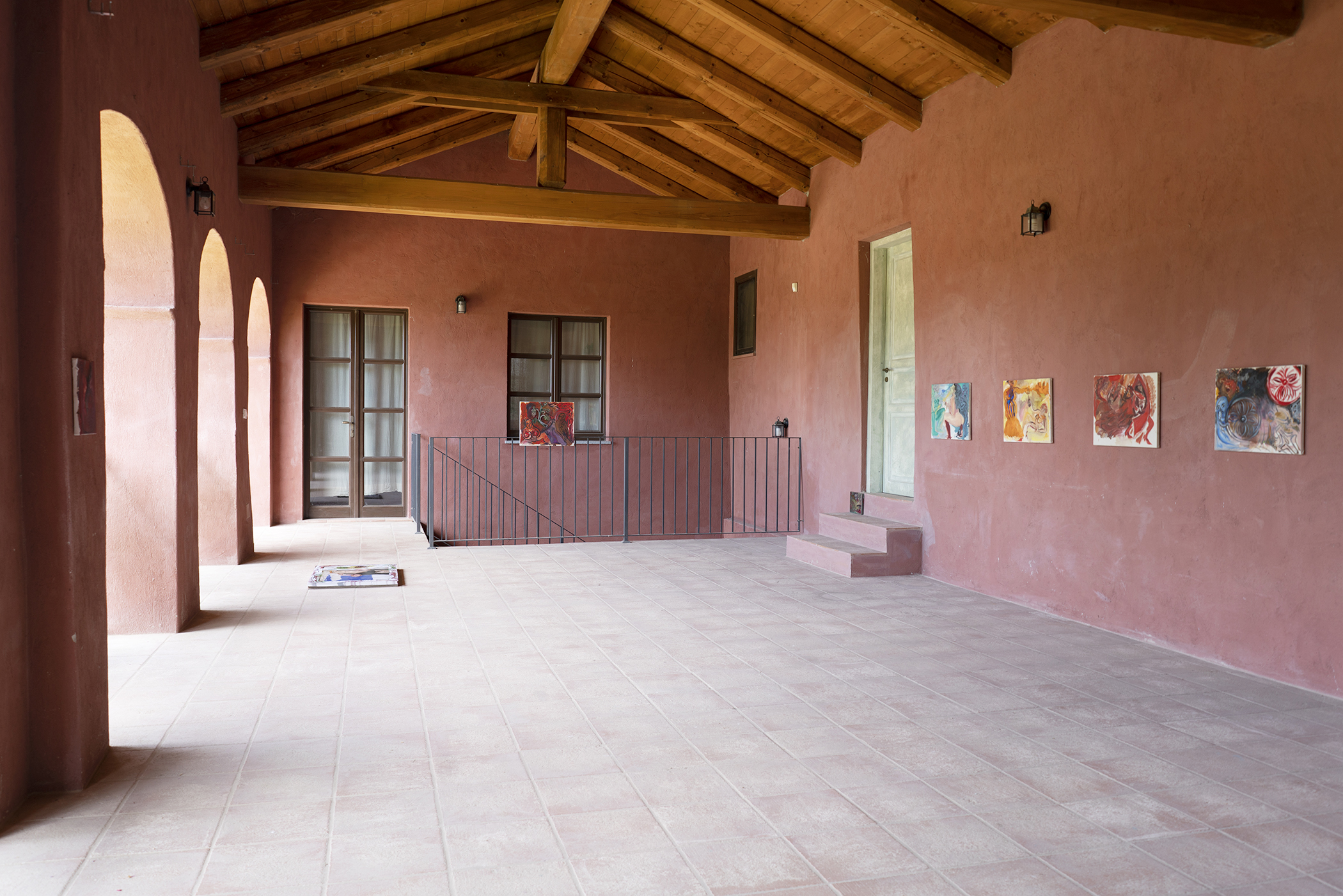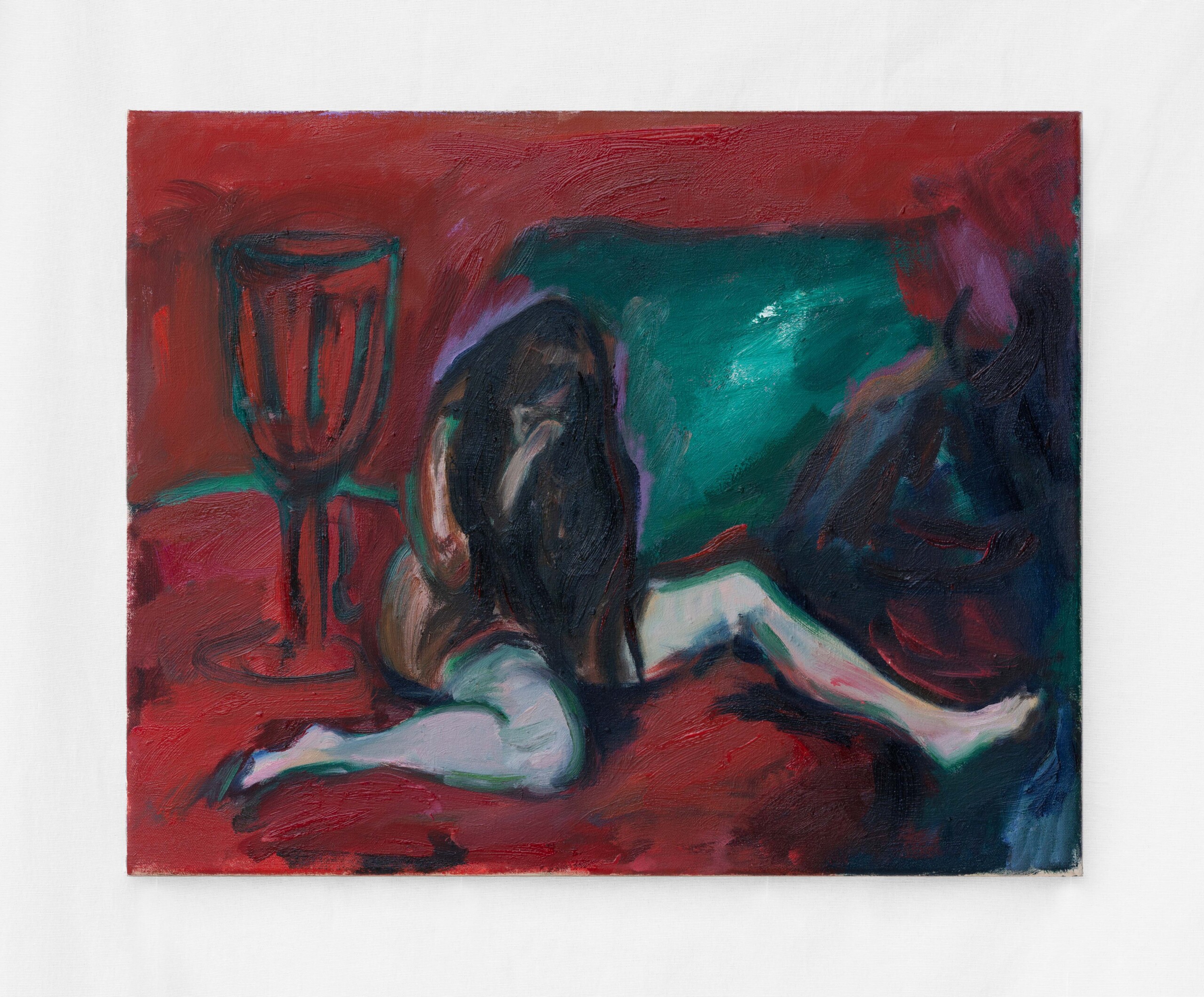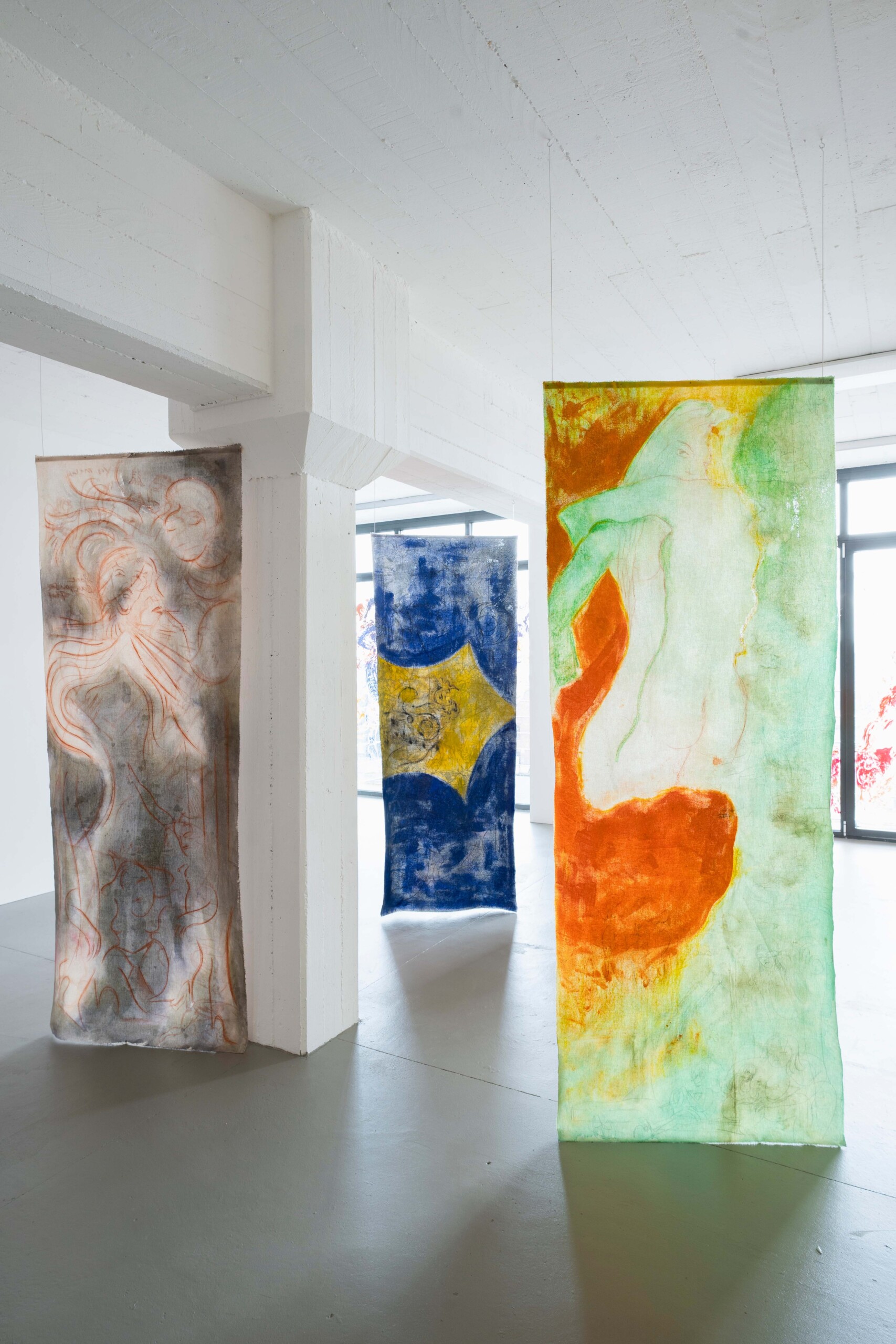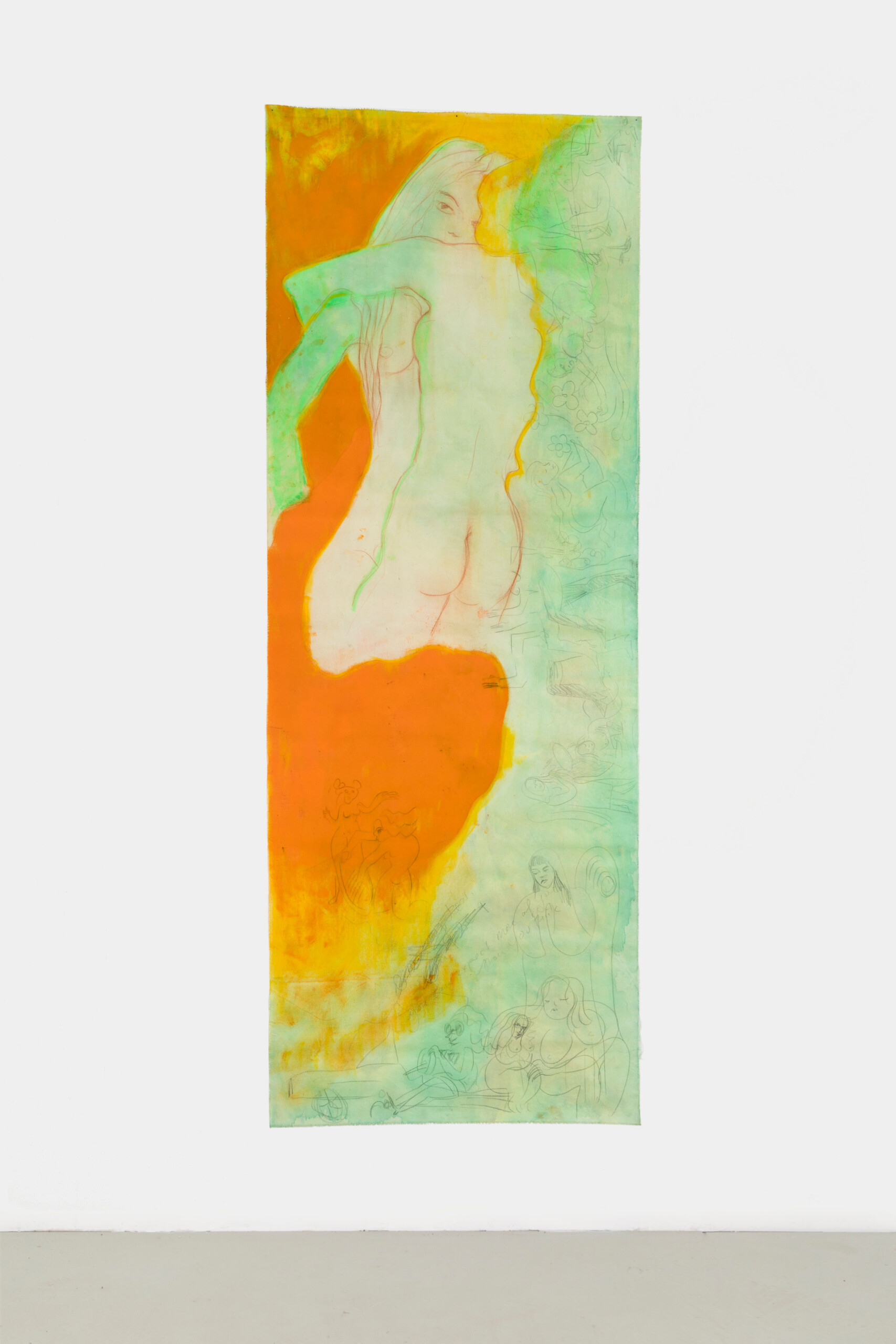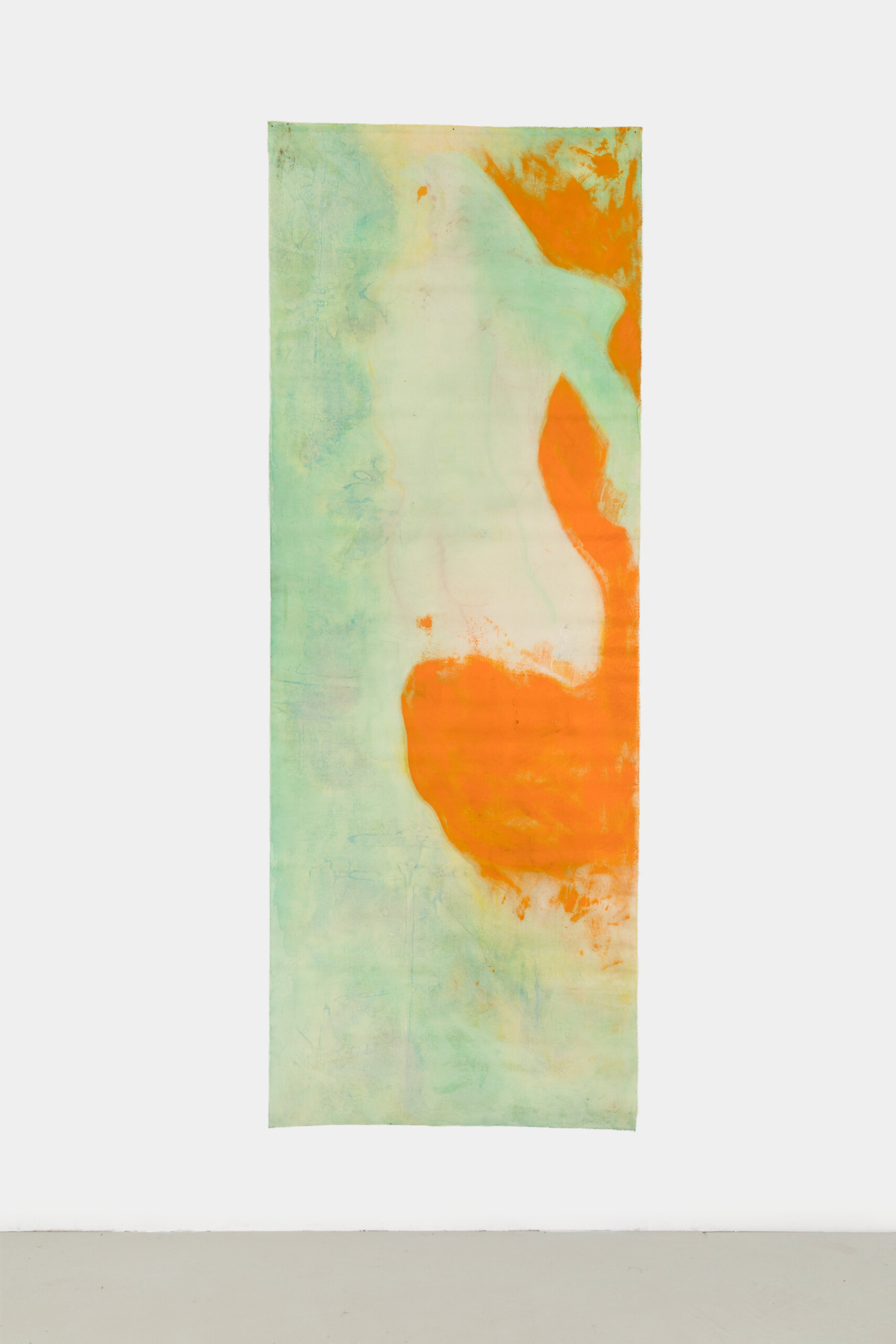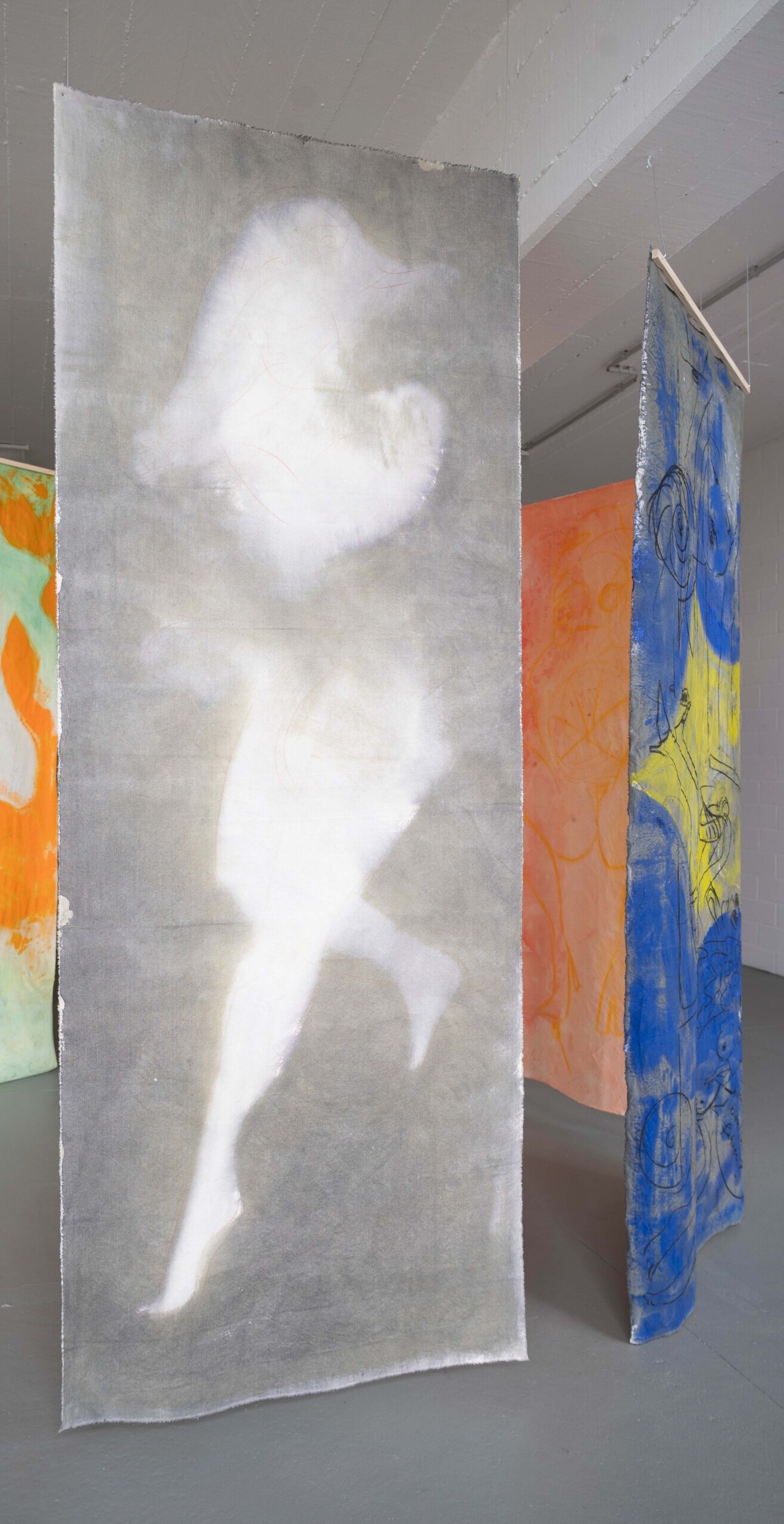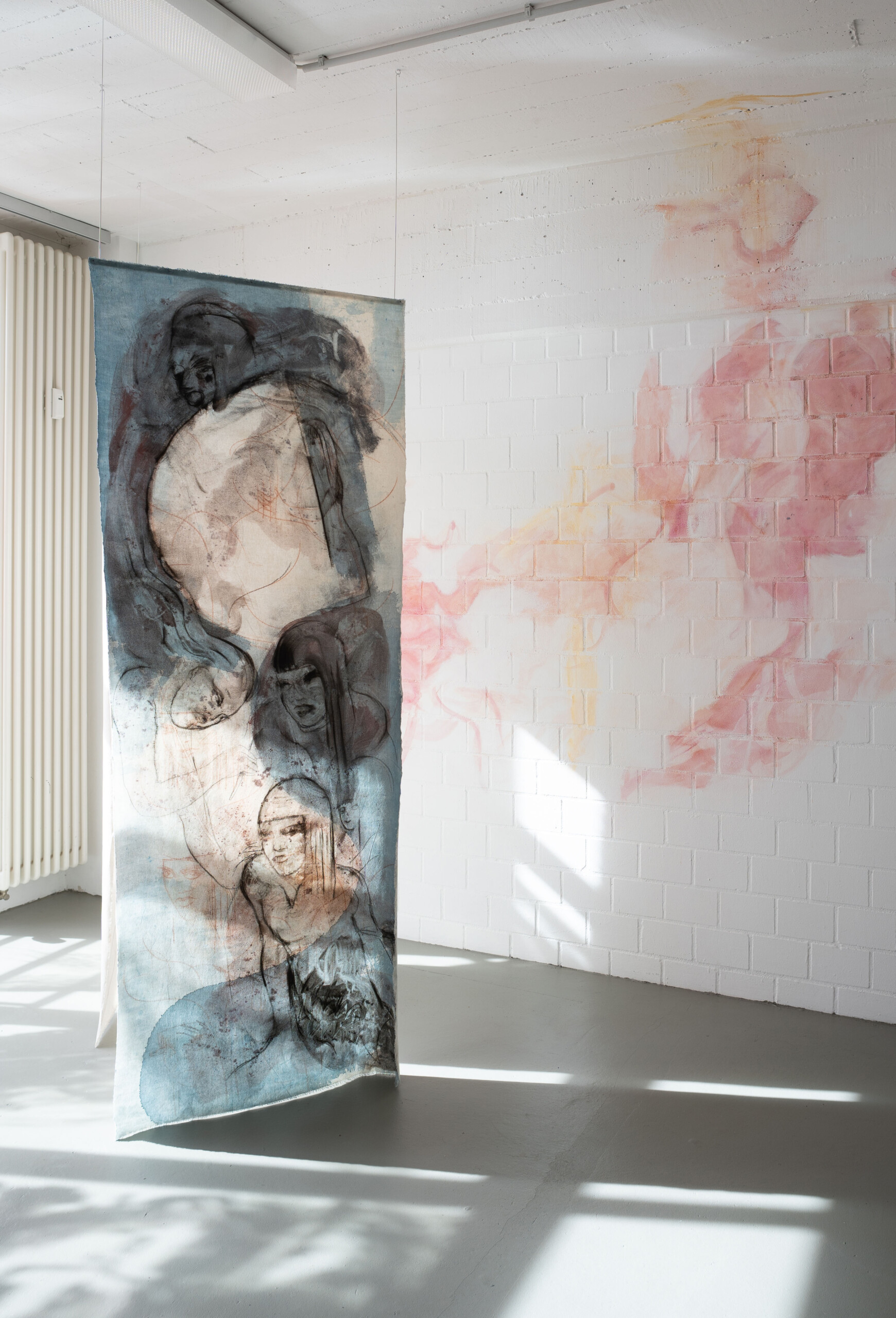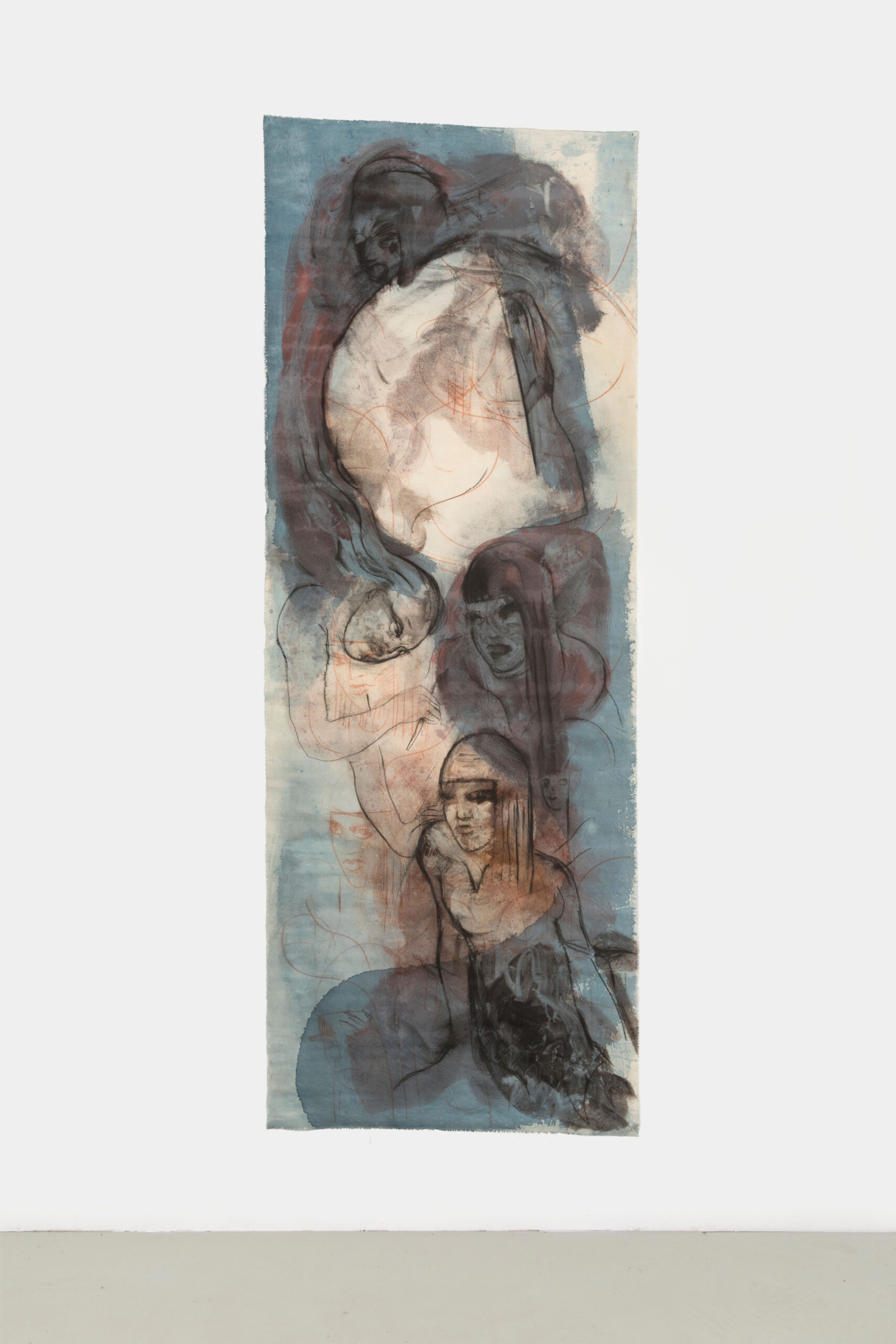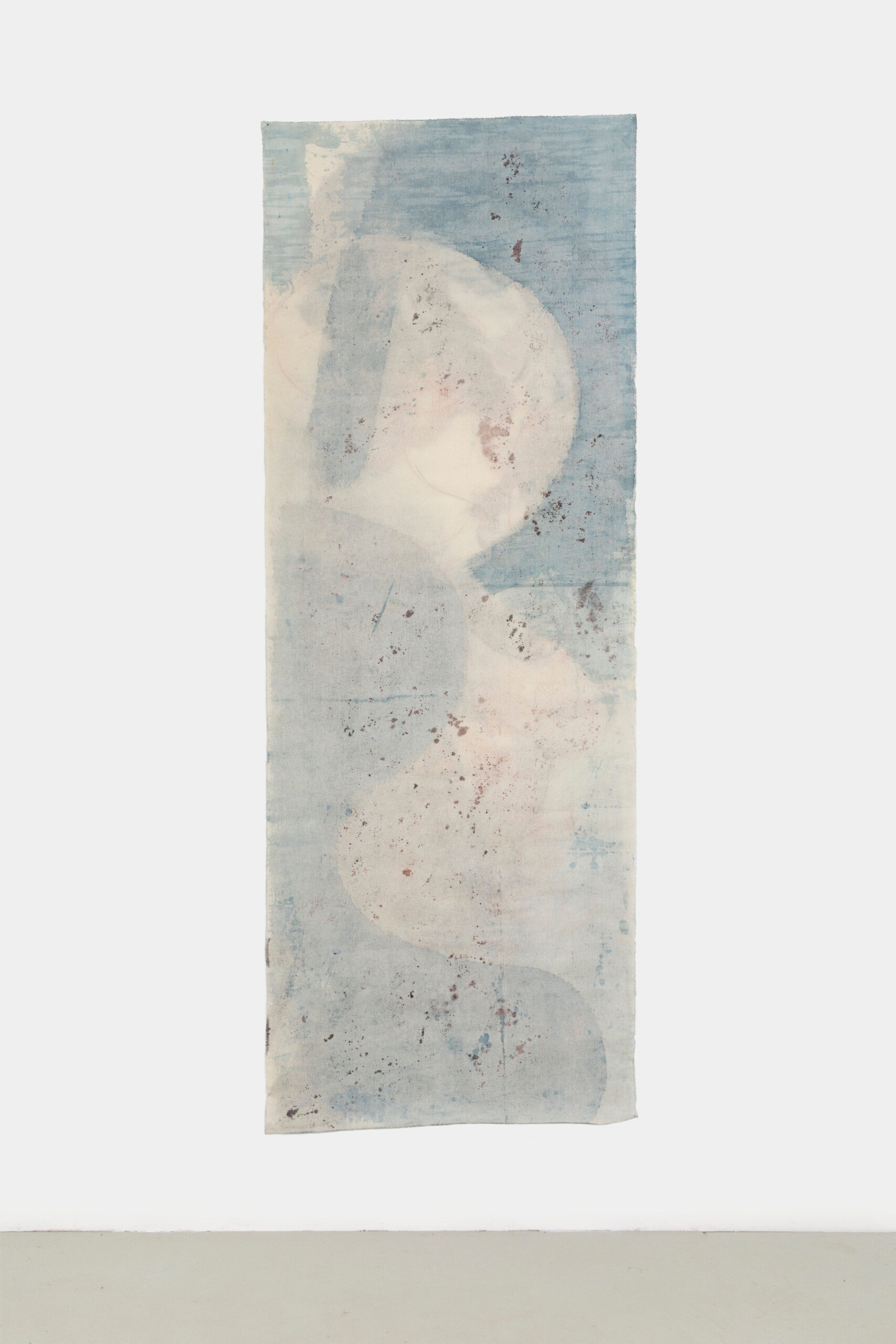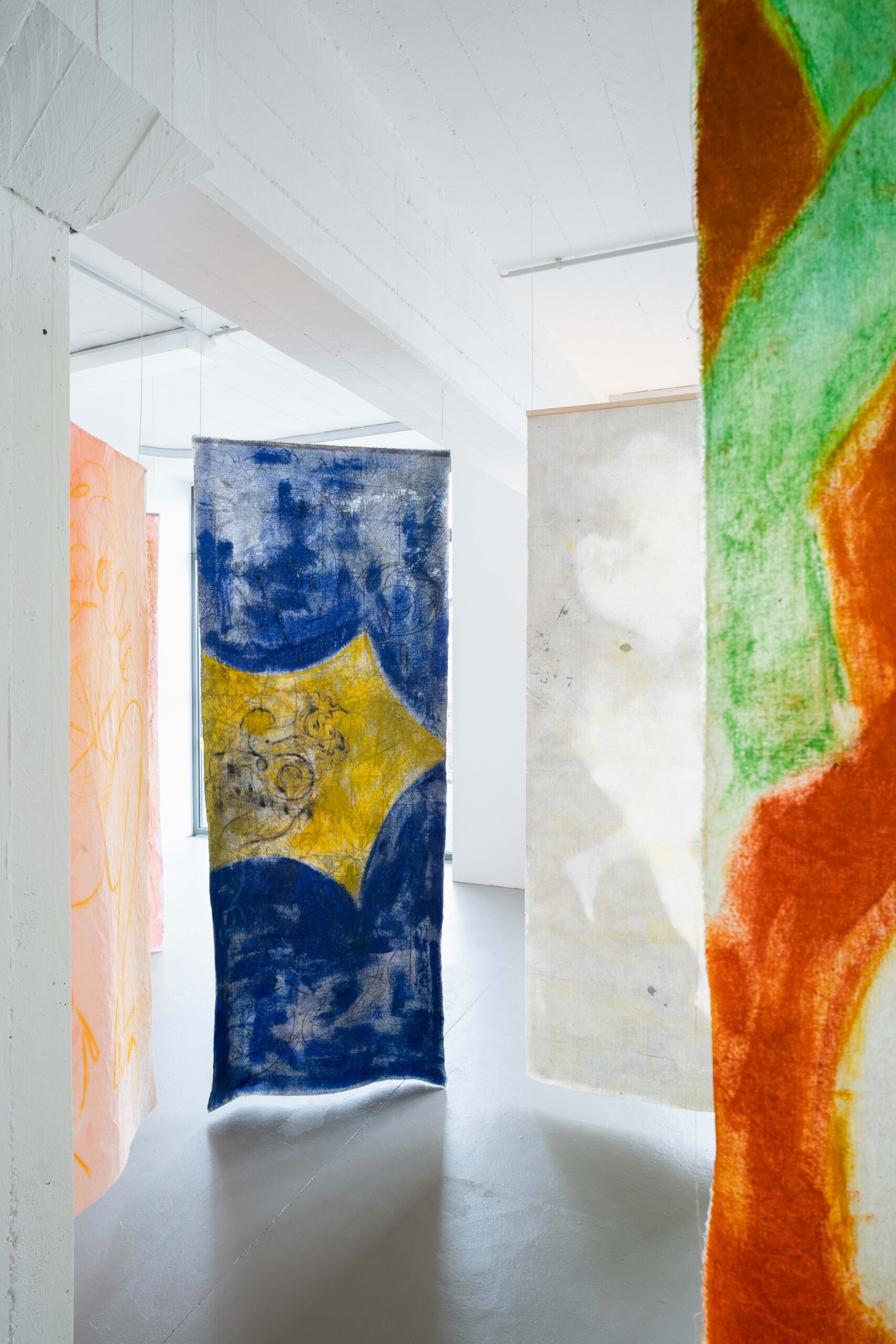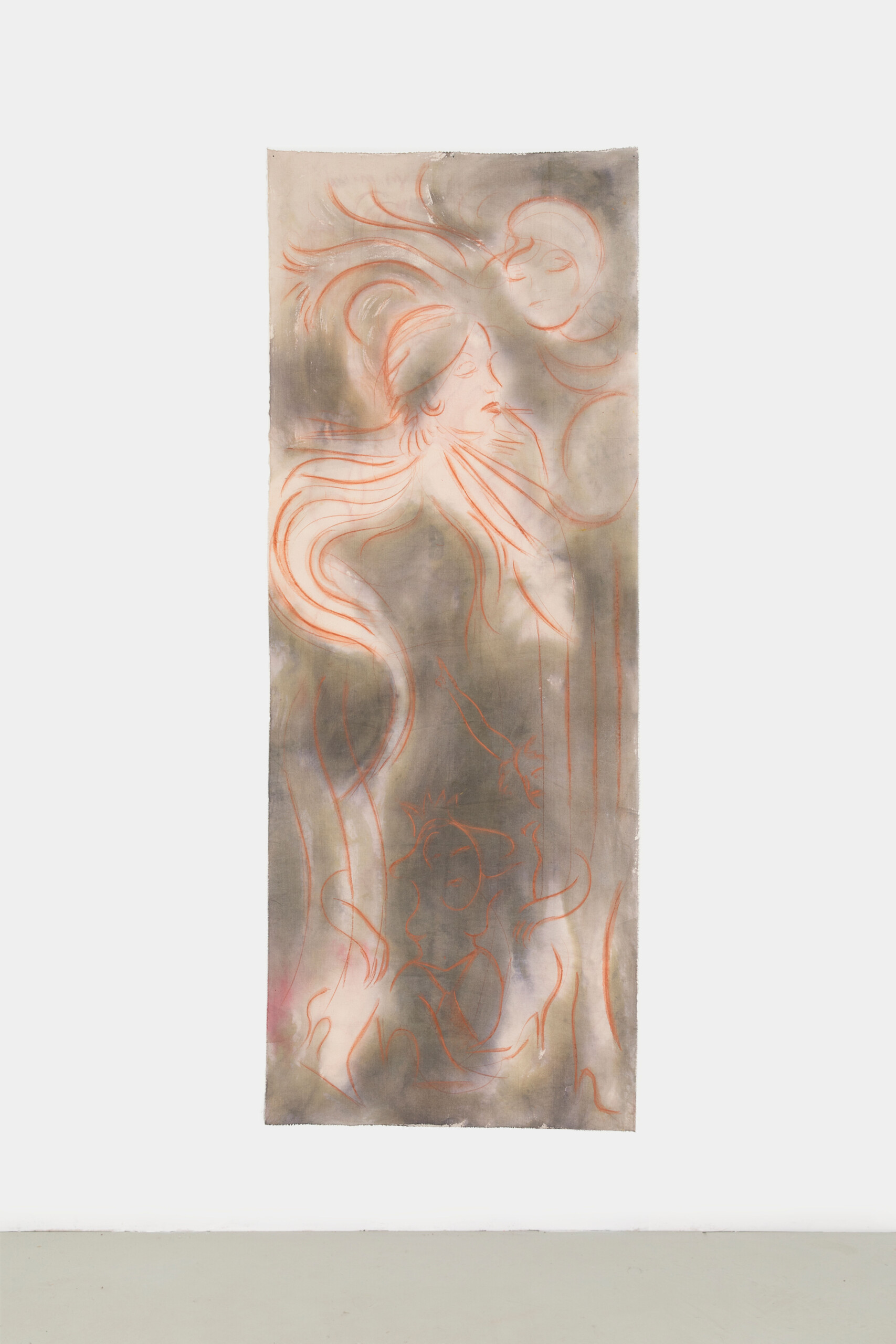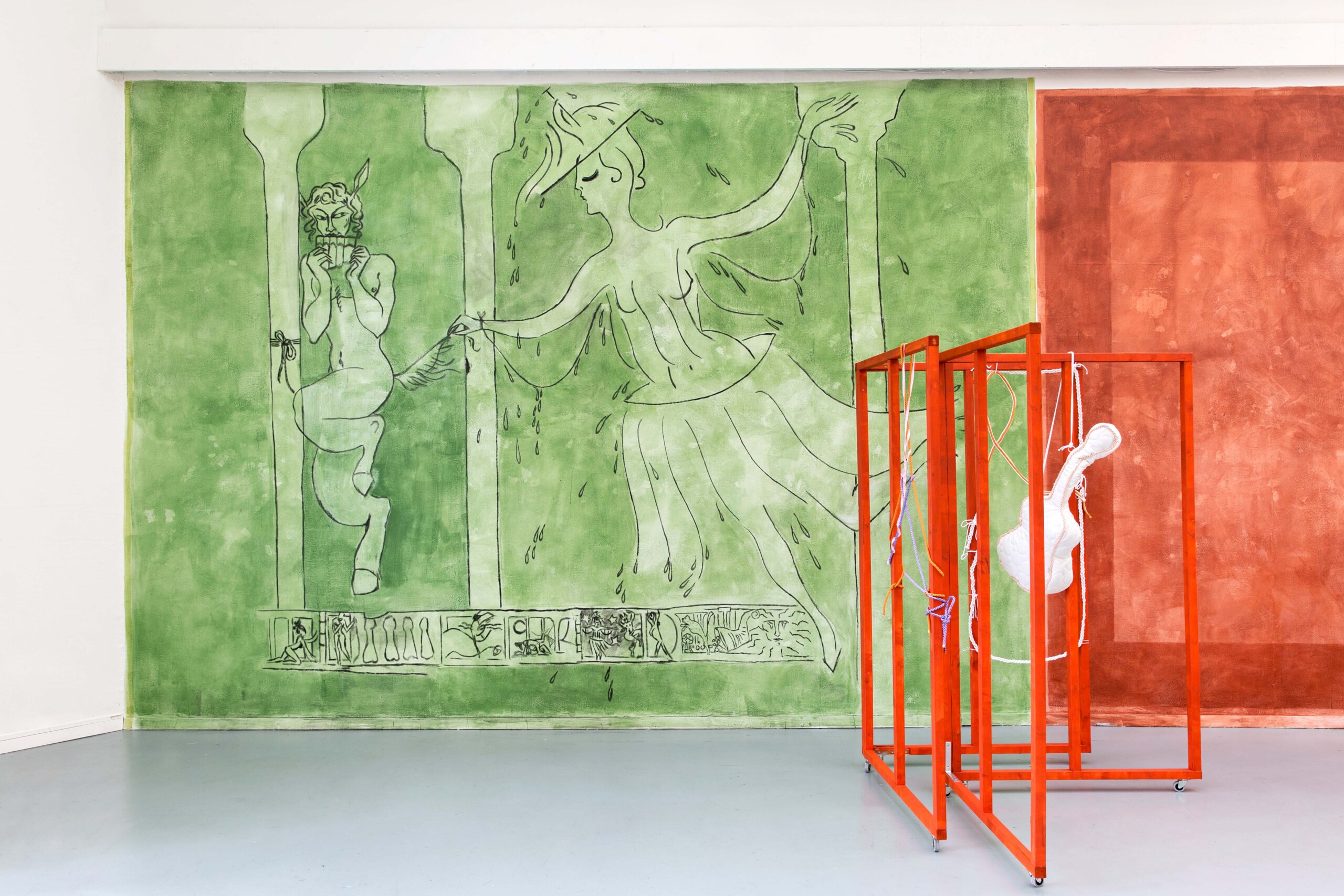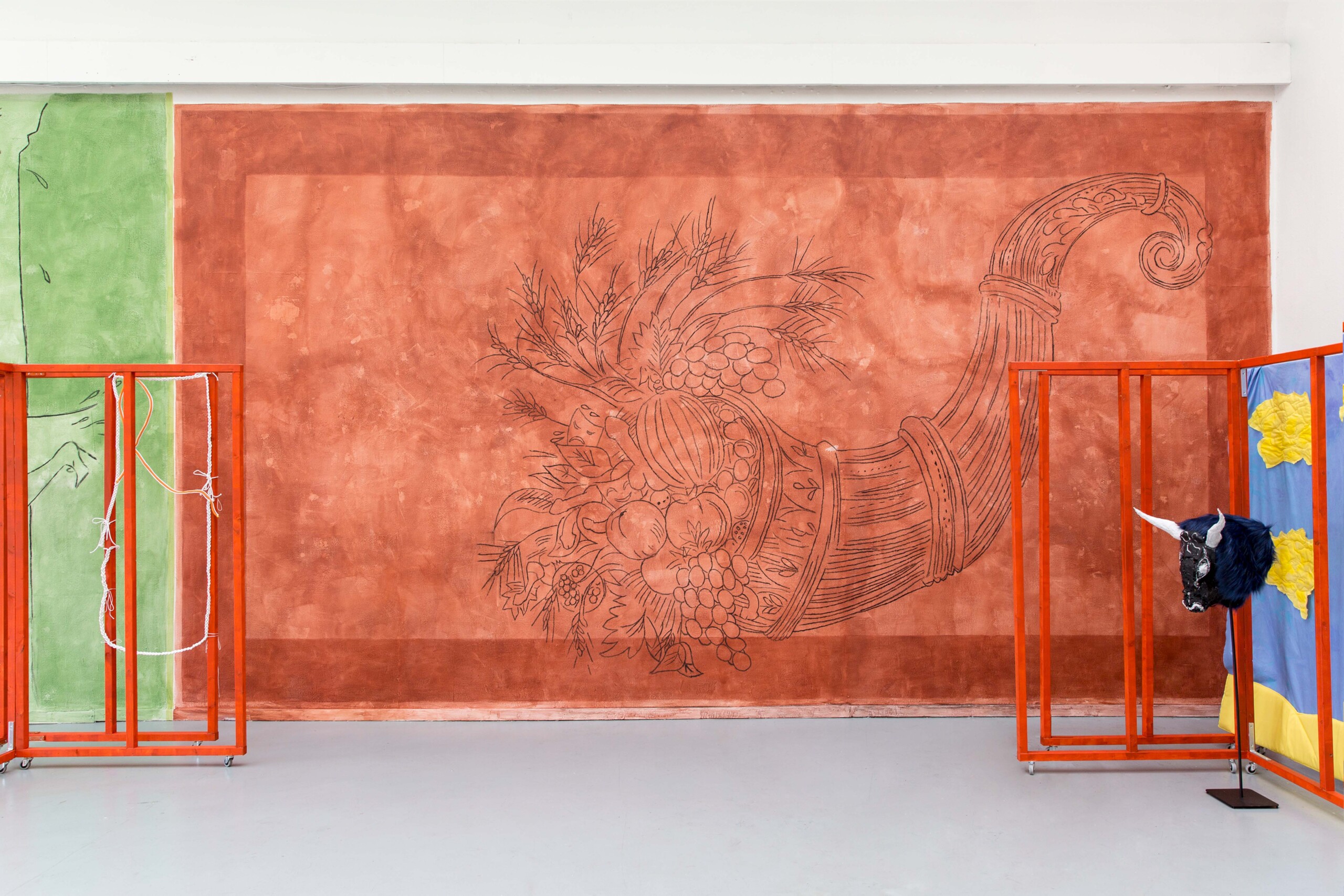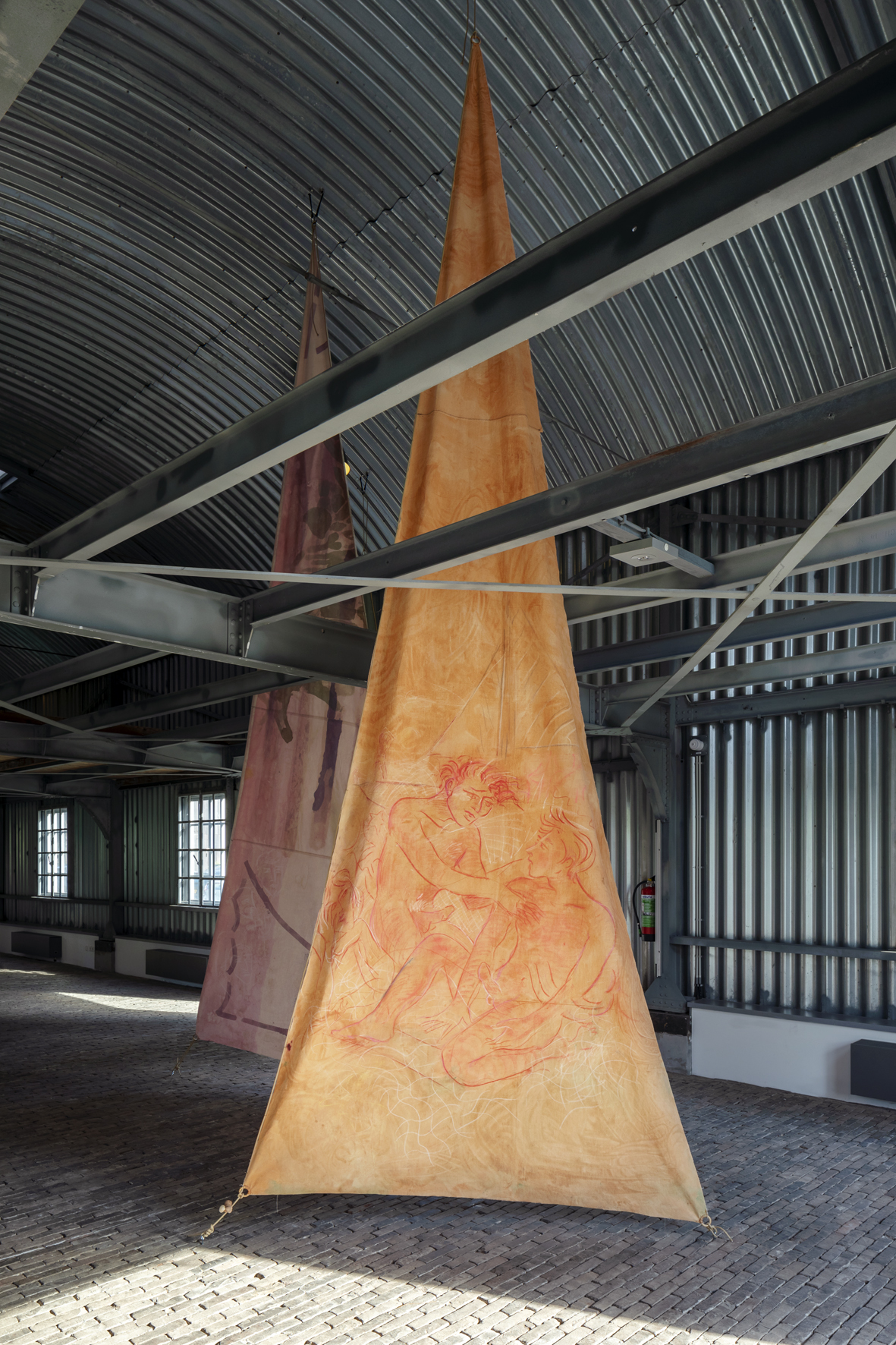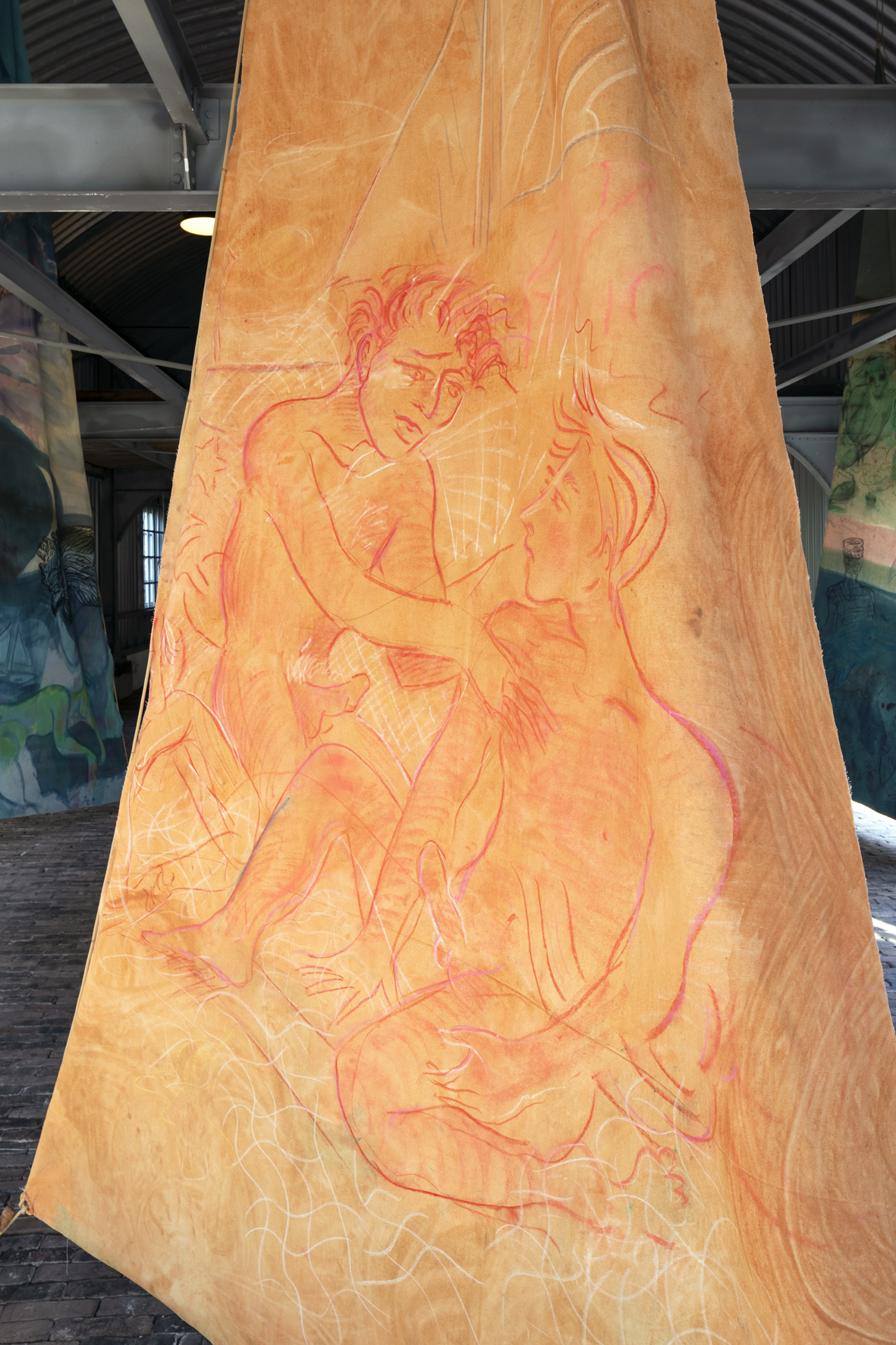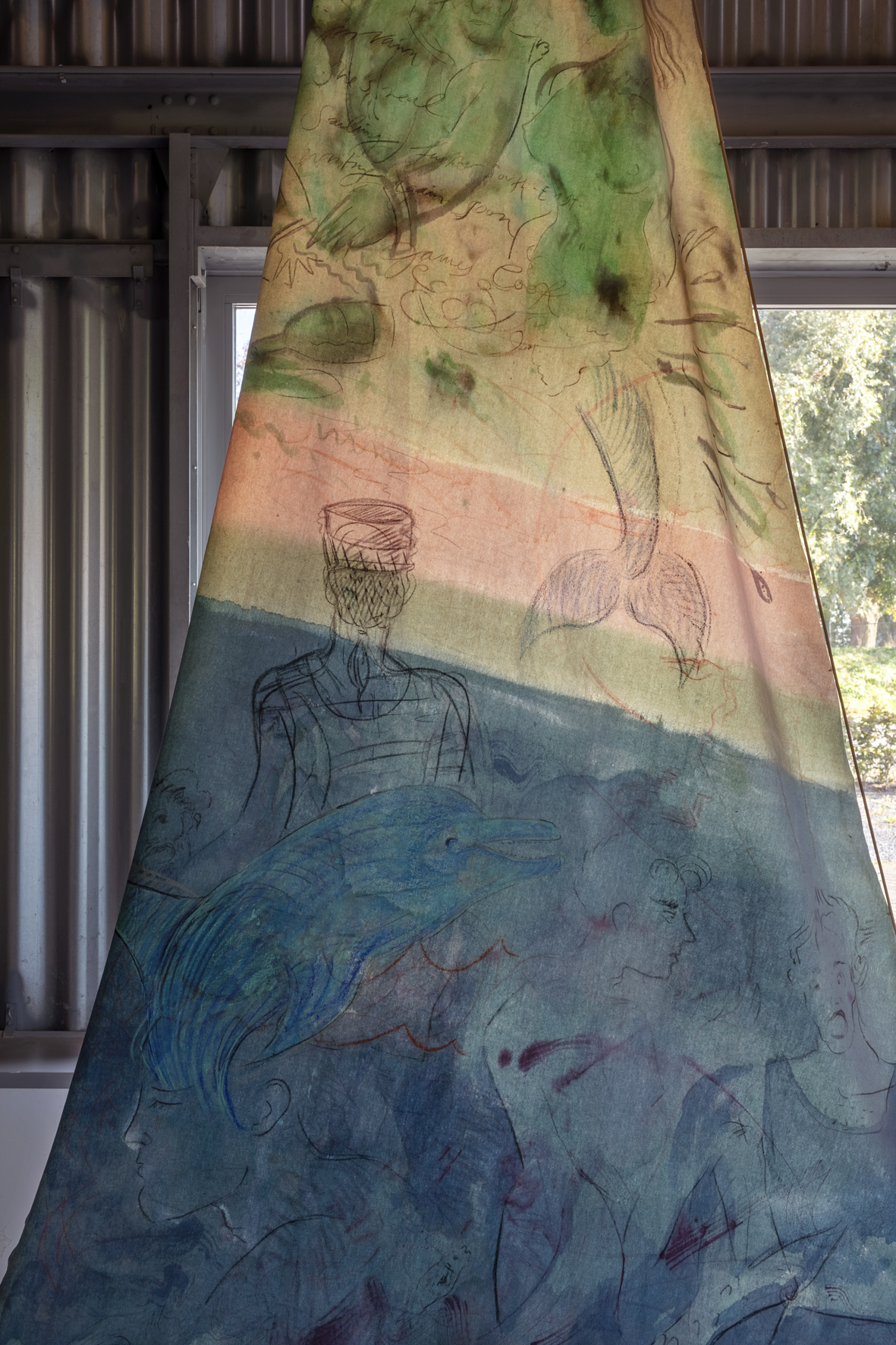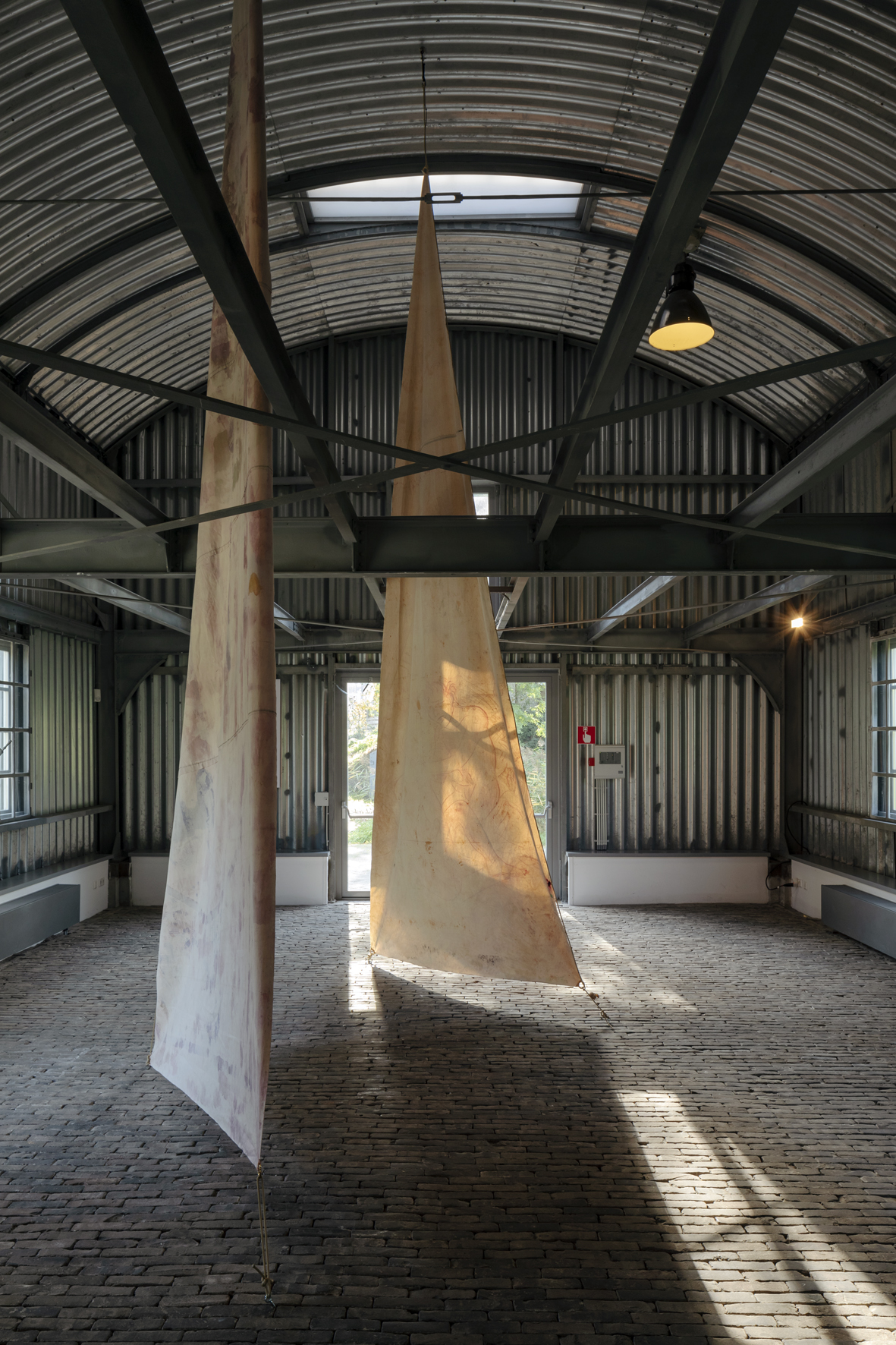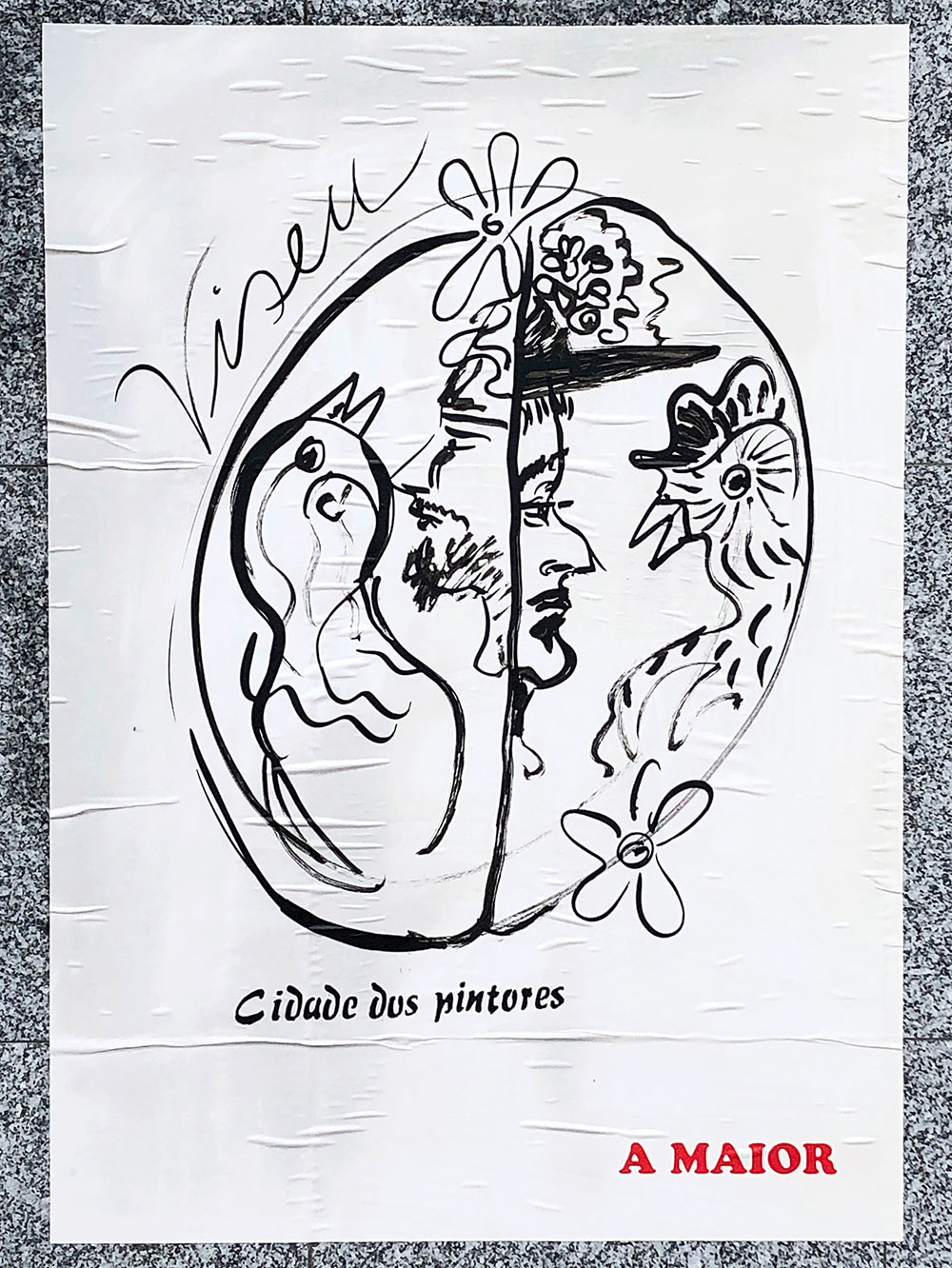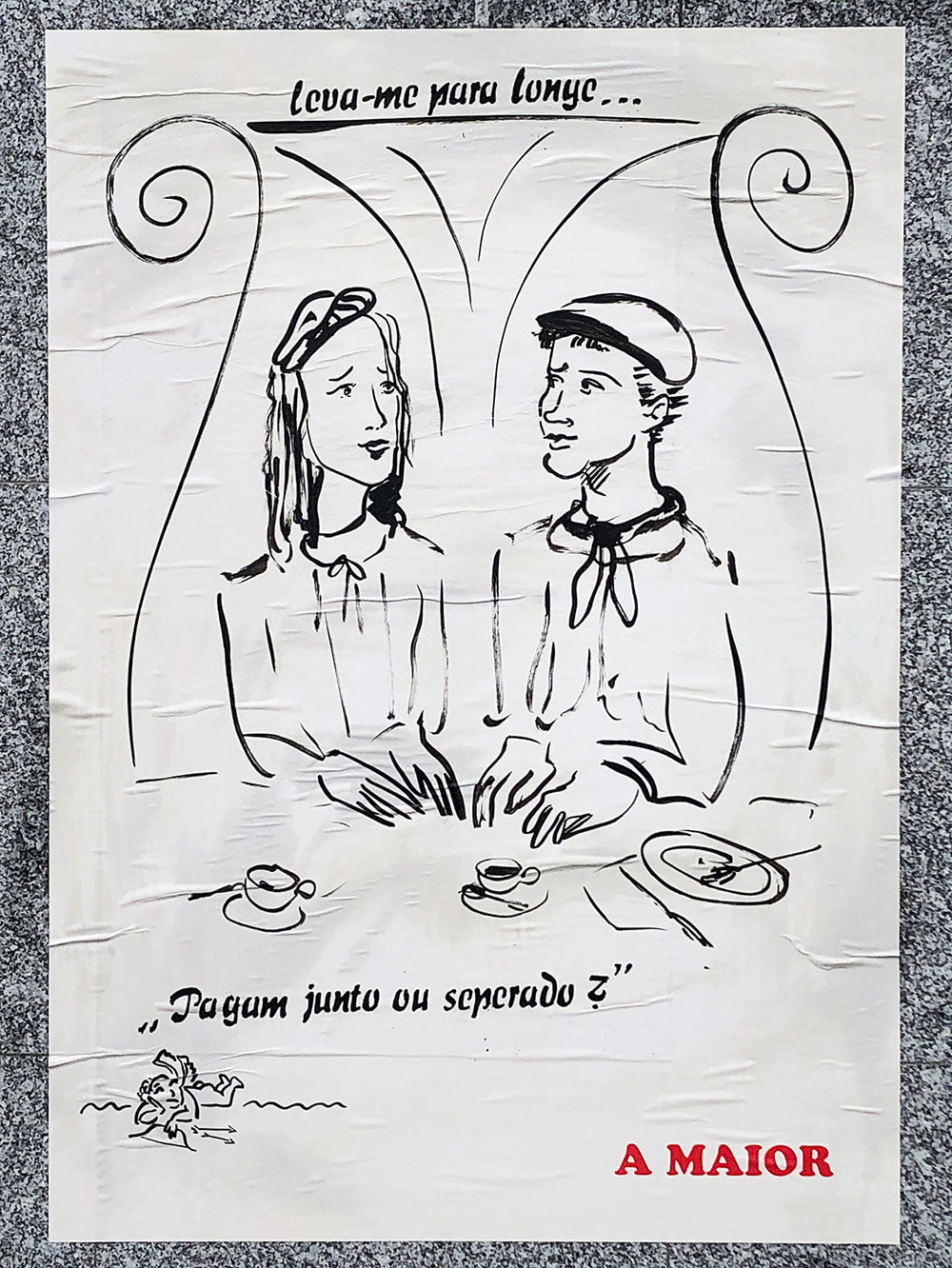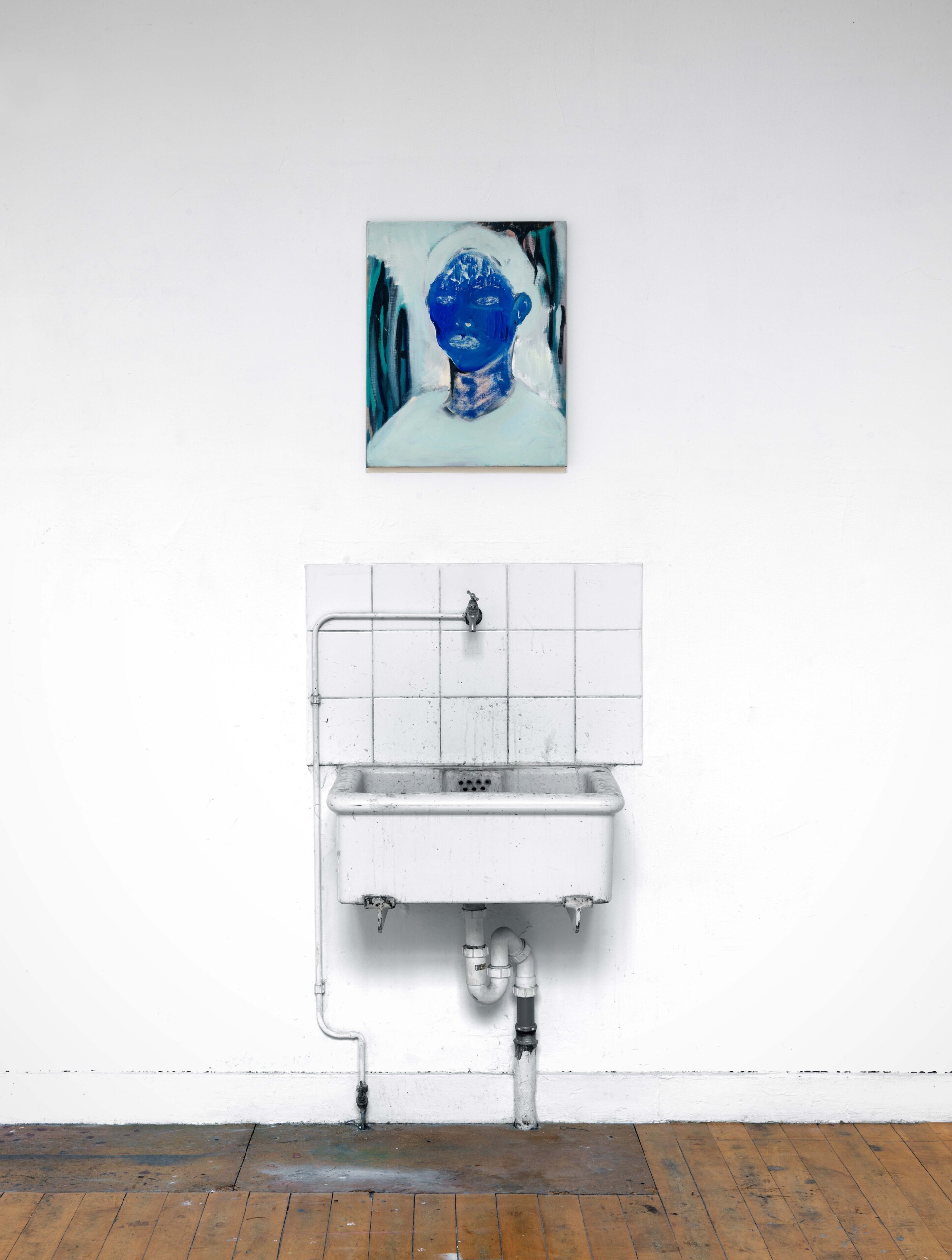Charlott Weise | online portfolio

Charlott Weise, F.f., 2017
ink, red wine, acrylic on molton, 300 x 800 cm
Reflecting upon how femininity is performed across a range of cultural fields, from historical figurative painting to literature and the mainstream media, Charlott Weise’s (b. 1991, Görlitz, Germany) work can be seen as a form of intuitive image-based writing. In these images, interior worlds unfold as rich narrative mise-en-scène; female archetypes find themselves slipping between, in and out of, thick plotlines both banal and bombastic.
Select works
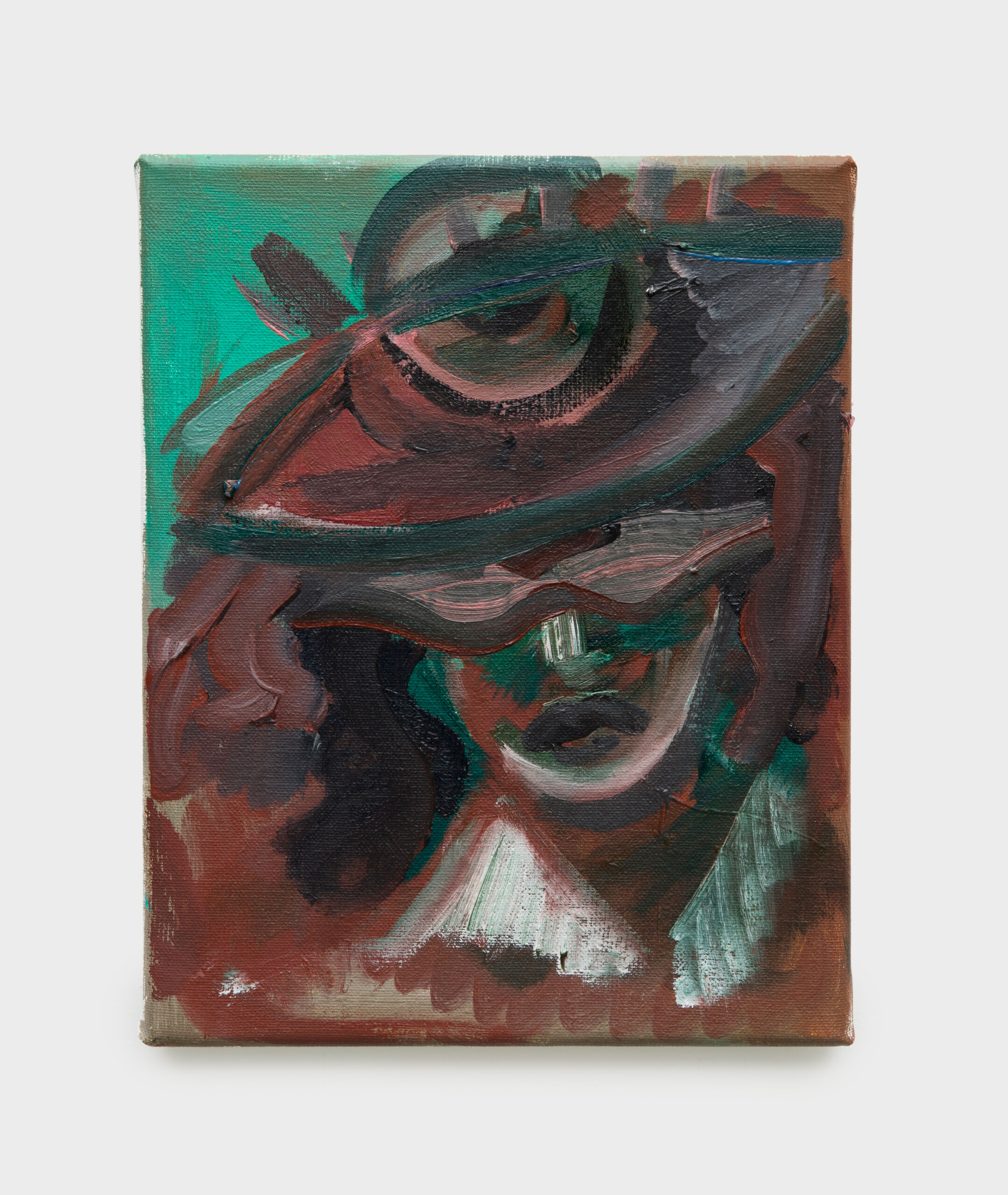
Charlott Weise, Petit œil, 2022
oil on canvas, 20 x 30 cm
£2,200 (ex vat)

Charlott Weise, Echos Sängerkreis, 2022
oil on canvas, 200 x 170 cm
£15,000 (ex vat)

Charlott Weise, Ladaia, 2016
oil, charcoal on canvas, 210 x 150 cm
£12,800 (ex vat)
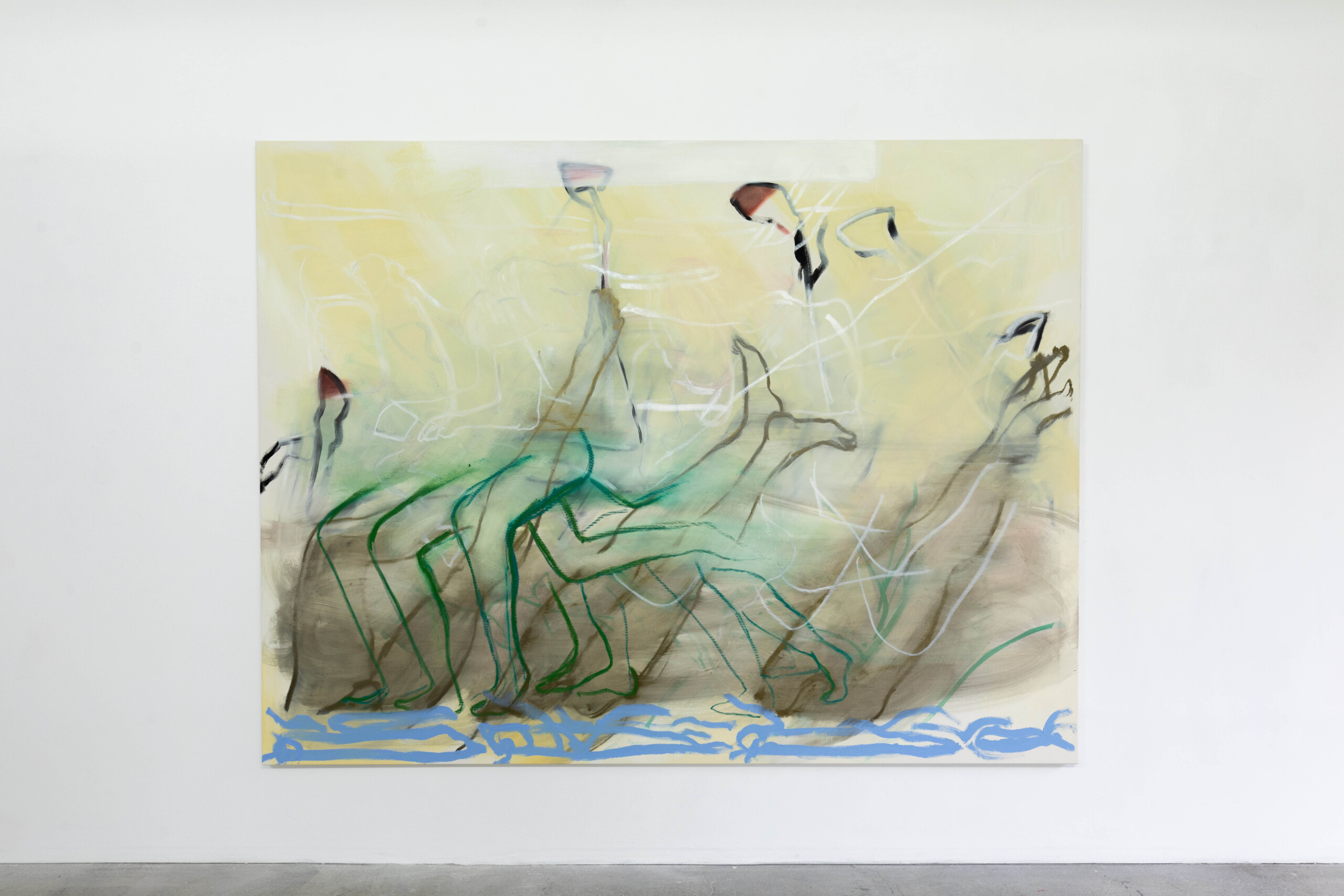
Charlott Weise, Y’a du Zeph, 2025
oil and silver, bronze, naples yellow oil stick on canvas, 190 x 250 cm
£15,000 (ex vat)

Charlott Weise, A thousand lips, 2022
pencil, China marker, oil on paper, 29 x 21 cm
£1,500 (ex vat)
exhibitions and series
Y‘a du Zeph, 2025
Treignac Projet, Treignac (France)
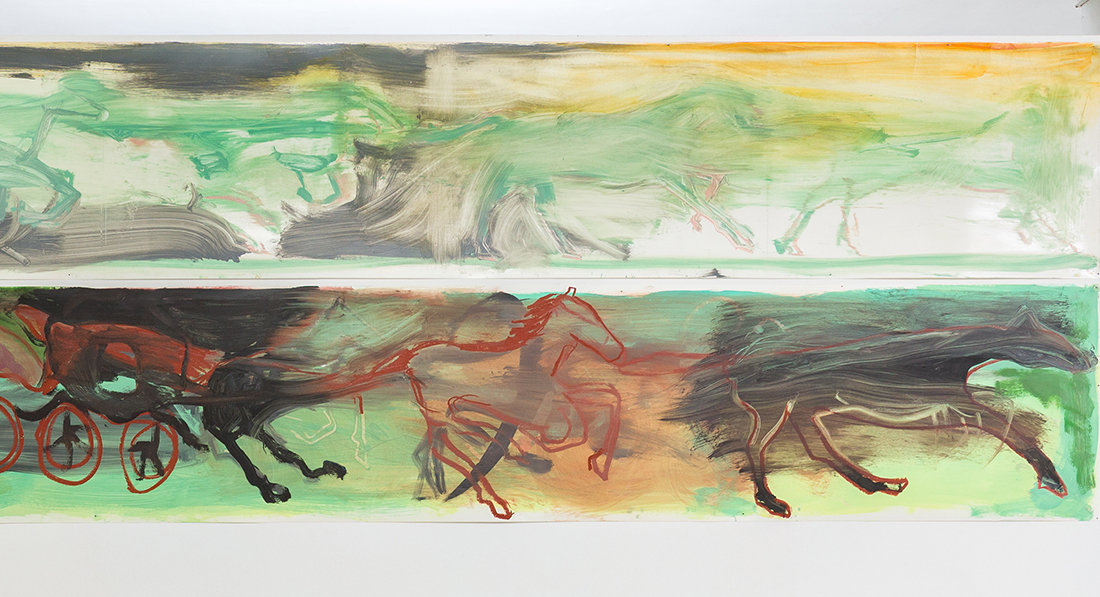
Charlott Weise, Galloping Leg Study (1 + 2) (detail), 2025
oil on paper, 50 x 350 cm
Charlott Weise’s latest body of work, produced for her debut institutional solo exhibition in France at Treignac Projet also reflects this approach. Comprising eleven paintings, the series centres on the horse as a powerful visual and symbolic motif. The exhibition, titled Y’a du Zeph, a colloquial French expression suggesting turbulent weather and evoking the zephyr, the ancient god of the wind, uses the equine figure as a means to explore ideas of movement and transformation both as painterly concerns and as broader modes of inquiry.
Lines, forms, and colours recur throughout the series, with several works marked with smudged bronze or silver oil stick that lends the surfaces an iridescent sheen. Each painting slips into the next, as if carried by the wind, or like frames from a film, fragmented and dispersed across the galleries. The exhibition opens with a scene reminiscent of the bucolic scene found in Bresson’s own film, Apparition. This small-scale painting presents the blue outline of a horse’s head, mounted by a human figure and serves as a quiet prelude to a larger work Escape the Chariot, which hangs on the opposing wall.
In this painting, the horse’s body is captured mid-motion, its head blurred by the velocity of its own movement and the artist’s roving eye, or camera. As it reaches towards the edge of the room, the headless body appears to loop back to the first painting that opens the space, its bodiless counterpart, as if the two were fragments of a single image. This circular gesturing leads the viewer toward the second part of the exhibition, which unfolds across the upper floor galleries.
figuration, equine animals have long functioned as an emblem of movement.
Charlott Weise, Girandola, 2025
Venetian / English red and silver oil stick on canvas, 170 x 350 cm (diptych)
Charlott Weise, Escape the Chariot, 2025
oil on canvas, 130 x 250 cm
Charlott Weise, Y’a du Zeph, 2025
oil and silver, bronze, naples yellow oil stick on canvas, 190 x 250 cm
£15,000 (ex vat)
Charlott Weise, Apparition, 2025
oil on linen, 40 x 30 cm
Charlott Weise, Neckerei (dans le jardin), 2025
oil and oil stick on canvas, 200 x 160 cm (two panels, diptych)
Charlott Weise, Amadeus Shoes (installation view), 2025
oil on canvas, 50 x 40 cm
Charlott Weise, Galloping Horse Nebula, 2025
oil on canvas, 170 x 250 cm
Text by Juliette Desorgues
Robert Bresson’s seminal film Au hasard Balthazar from 1966 opens with a tender, fragmented image of a donkey’s hind legs and back, its calf reaching for milk, as the distant bleating of a herd of sheep echoes through the frame. What begins as a scene of apparent pastoral idyll gradually unfolds into a harrowing tale of suffering, tracing the animal’s life through a series of human cruelties and indifferences. At the time of its release, some critics dismissed the film’s austere tone and apparent mundanity. Indeed, Ingmar Bergman famously quipped, “It was so boring I fell asleep … A donkey, to me, is completely uninteresting.” [1]
For Bresson, however, the donkey was anything but. The equine animal is used in his film as a way of interrogating the very mechanics of cinema; an anti-heroic figure which serves to dismantle narrative conventions. In line with his post-war French film contemporaries, Bresson rejected the motion of plot-driven spectacle and linear causality akin to mainstream film in favour of a cinematographic language grounded in stasis and restraint. In Au Hasard Balthazar, his focus on the humble figure of the donkey enables the construction of tightly composed tableaux in stark chiaroscuro, which unfold with the formal rigour of a sequence of paintings.
If Bresson saw in the donkey a path toward a more painterly conception of moving image, the reverse has often been true for painters. From the prehistoric gestural renderings on the cave walls of Lascaux and Chauvet to religious iconography where horses are cast as harbingers of death, ushering in the end of the world as in Albrecht Dürer’s The Four Horsemen from The Apocalypse (1498), to Susan Rothenberg’s horse paintings (1974–1980), which reimagine the animal in her resistance to the rigidity of minimalism and exploration of figuration, equine animals have long functioned as an emblem of movement.
Sketches for the Future, 2024
miart, Milan (Italy)

Installation View
In Charlott’s paintings, interior worlds unfold as rich narrative mise-en-scène; female archetypes find themselves slipping between, in and out of, thick plotlines both banal and bombastic. Finding inspiration in Clarice Lispector’s novel The Passion according to G.H., the five-panel frieze, Herself In Passage (2020), presented at miart reads as an absurdist layering of diaristic entries — as literary fragments cut from an existence — which weave together to render the temporal nature of being; or at least to demonstrate how a being is an innately liquidus thing, a washing together of emotive states beyond the didact and the logistically discernible. For Charlott, the intuitive process of applying oil to canvas holds a capacity to communicate sensory experiences which words alone cannot embody. Echoing the attentiveness of Lispector’s prose, Charlott’s narrative is a mighty record of an anomalous life — be this the life of Lispector’s protagonist, Charlott’s own or a subconscious weaving of the two. Human in scale, the multivalent scenes of Herself In Passage not only envelop us within the throes of a slippery storyline but arouse a subjective encounter, one wholly conjured through the poetic action of putting paint to canvas.
—booth text
Charlott Weise, What does constitute a consummation?, 2023
drypoint diptych on Somerset paper, 28.5 x 37.5 cm (each)
Charlott Weise, What does constitute a consummation?, 2023
drypoint diptych on Somerset paper, 28.5 x 37.5 cm
Charlott Weise, What does constitute a consummation?, 2023
drypoint diptych on Somerset paper, 28.5 x 37.5 cm
Pairing a vacant snake peering past a set of ships’ portholes and a well-dressed woman tickling a cocktail, in recline, pausing as if in mid thought, Charlott Weise’s diptych, What does constitute a consummation? (2024), can be read as a tragicomic conversation. “Let’s play theatre and discuss the grand theme of love”, to quote the artist.
A musing, created over the course of one printing session, like a diary entry, What does constitute a consummation? materialises as a double portrait of melancholy and desire; that feeling one gets reflecting on a forever changing love, platonic or otherwise. Indeed, that feeling one gets in anticipation of something soon to be bourgeoning.
Emerging from her extensive drawing practice as well as the formal experiments that happen within and beyond the space of her studio, What does constitute a consummation? directly connects to the core of Charlott’s artistic outlook. Across the drypoints mise-en-scène, aspects of theatrical refinement rub up with the exuberant and free thinking, creating a complex image world. An anomalous place, abounding through line.
Given the resonances with Charlott’s practice, it is fitting that all proceeds raised from this edition will be used to fund her first artists’ publication, Schade um jeden Kuss. Devoted to Charlott’s drawing practice, this publication will have a limited run of 66 copies.
Charlott Weise, Schade um jeden Kuss, 2024
artist publication
£88
Charlott Weise, Schade um jeden Kuss, 2024
artist publication
£88
Charlott Weise, Schade um jeden Kuss, 2024
artist publication
£88
Charlott Weise, Schade um jeden Kuss, 2024
artist publication
£88
Charlott Weise, Schade um jeden Kuss, 2024
artist publication
£88
Charlott Weise, Schade um jeden Kuss, 2024
artist publication
£88
For these thoughts we change into pink, 2024
Belmacz, London (UK)

Charlott Weise, For these thoughts we change into pink, 2024
installation view
An exhibitionary melodrama, one writ through the “ecstatic impulse” of painting, For these thoughts we change into pink is Charlott Weise’s first solo exhibition in the UK.

Charlott Weise, Untitled (Reboot Rokeby), 2023
oil on canvas, 200 x 130 cm
Charlott Weise is concerned with being in the world, with all its chaoticness and intoxication. Working fluidly, through the instinctual sojourns allowed for as a brush meets canvas, Charlott’s paintings attempt to resolve this experience of being in whilst also aiming to challenge or provoke what existence can be.
Writ in thick swathes of oil, Charlott’s paintings are more than acts of defiance; they stand tall as gestural traces pulled from the body, the mind. In this way, her works are more like allusive play scripts than solid, didact, narratives.
Following this premise, the forms and figurative suggestions—each reaped from Charlott’s extensive inventory of female iconography—that appear in the human-sized paintings and small drawn works in this exhibition act as theatrical portals; they linger as to create a quasi-Kafkaesque mise-en-scène.
—press release

Charlott Weise, Mamma Lupa, 2023
oil on canvas, 125 x 200 cm
£15,000 (ex vat). unique
Charlott Weise, Sisterwheel (front), 2023
paverpol, sanguine, eye shadow and essence on canvas , 210 x 80 cm
£7,000 (ex vat). unique
Charlott Weise, Sisterwheel (back), 2023
paverpol, sanguine, eye shadow and essence on canvas , 210 x 80 cm
£7,000 (ex vat). unique
Charlott Weise, Membrane Dancer (front), 2021
ink, paverpol and sanguine on canvas , 200 x 80 cm
🔴
Charlott Weise, Membrane Dancer (back), 2021
ink, paverpol and sanguine on canvas , 200 x 80 cm
🔴
Notes on Wine, 2021
NEVVEN, Castelnuovo Don Bosco, Italy
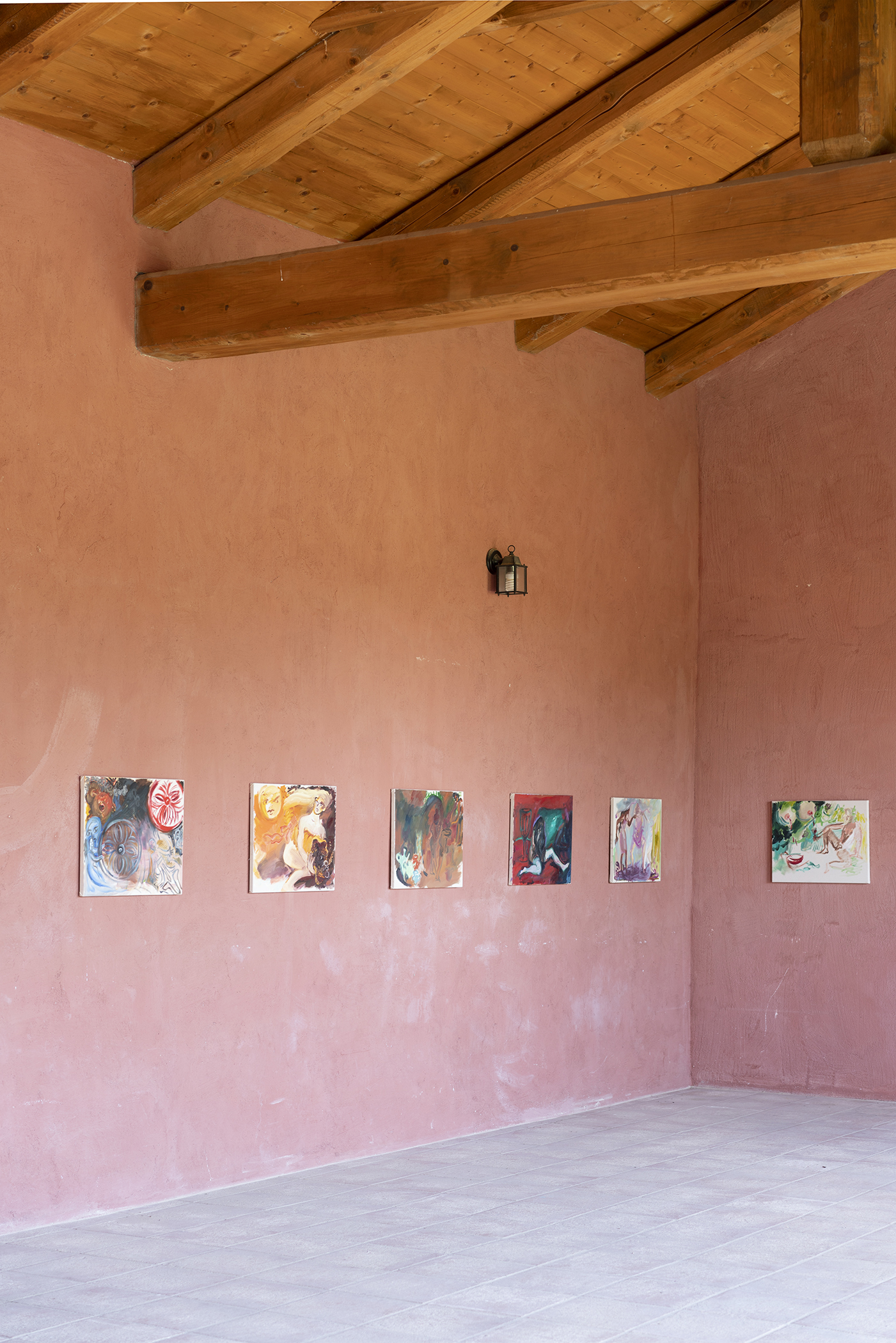
Charlott Weise
installation view, Notes on Wine, NEVVEN, 2021, Castelnuovo Don Bosco (Italy)
In this exhibition, the focus of Charlott’s thinking was wine, its literal, historical and cultural implications. Across painting, drawing and text, Notes on Wine emerged as a site-specific installation, one that not only accentuated the exhibition space but wich made the multifaceted associative histories of wine run together. Here, ideas and feelings, classical references and personal experiences mix loosely, fading in and out of one another, sometimes erotically, sometimes humorously, often both, conjuring scenes rich in speculative narrative.
Charlott Weise, Arvelé, 2021
oil on canvas, 40 x 50 cm
Charlott Weise, Grape stompers, 2021
oil on canvas, 40 x 50 cm
Charlott Weise, Busenwunder, 2021
oil on canvas, 40 x 50 cm
Installation View
Charlott Weise, Visions of Cortazzone #2, 2021
oil on canvas, 40 x 50 cm
Charlott Weise, Faunetti, 2021
oil on canvas, 40 x 50 cm
Installation View
Charlott Weise, Stain, 2021
oil on canvas, 18 x 25 cm
Charlott Weise, Weeping Girl (after Munch), 2021
oil on canvas, 40 x 50 cm
Tinted Glass, 2021
Kunsthalle Münster, Münster, Germany
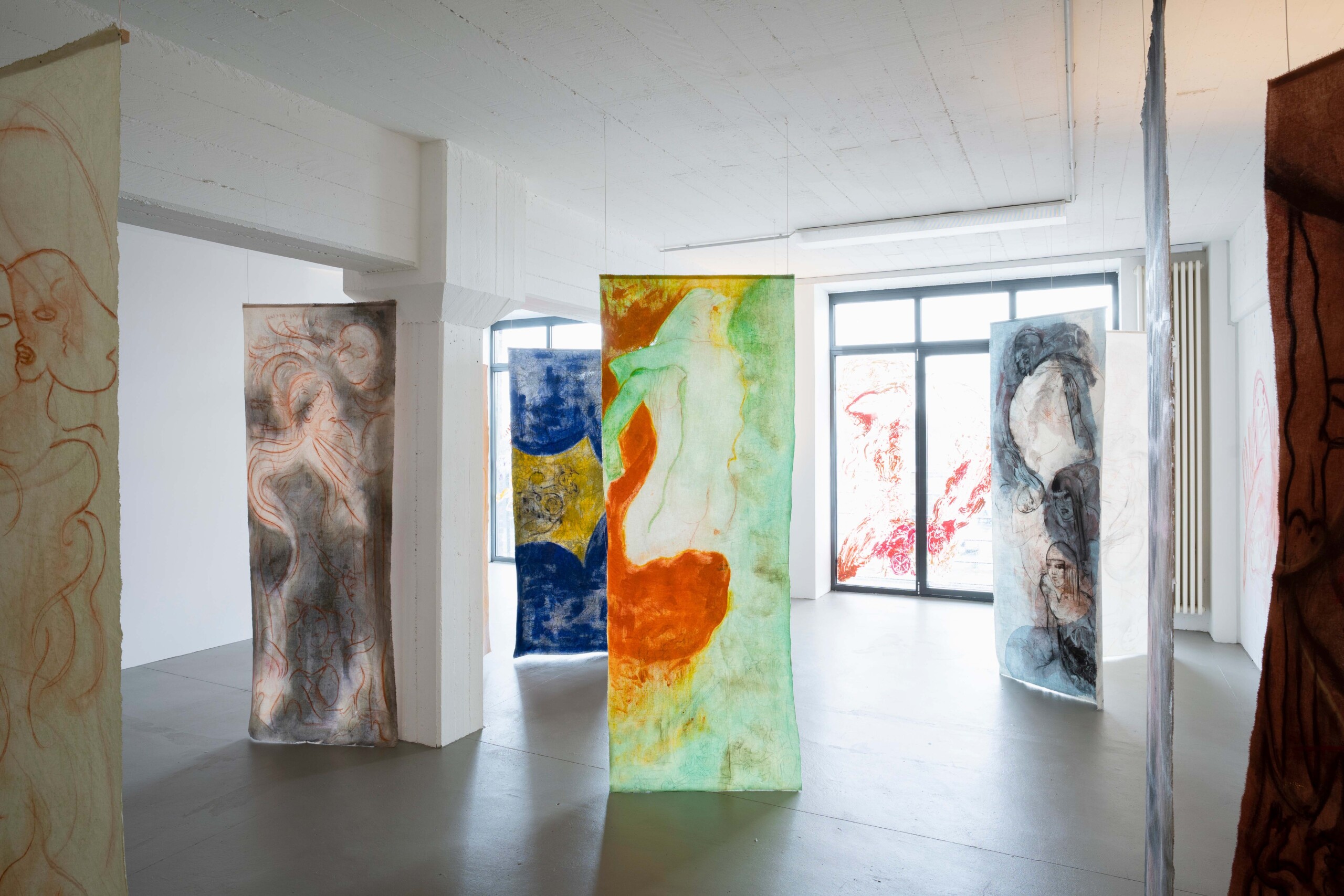
Charlott Weise, installation view, Tinted Glass, Kunsthalle Münster, 2021, Münster (Germany)
Tinted Glass evokes a changed perception with a before and behind, an inside and an outside. [In this exhibition,] the works are distributed throughout the room in elongated formats that are reminiscent of full-length mirrors. Their positioning creates a theatrical setting: the figures strike a pose, assume their roles—a spectacle is presented. In many of the works, both the front and back are painted, a principle that also appears in historical panel paintings, on the back of which a second representation was hidden, which often commented (in a moralistic way) on the front. When exposed to direct light, both sides overlap in Weise’s work. The translucency of the image medium becomes clear, whereby the unconscious, which forms a kind of subtext in the artist’s works, becomes visually apparent.
—Franca Zitta, 2021
Installation View
Charlott Weise, Breakfast at Marys, 2021
pigment, oil on cotton, 210 x 80 cm
Charlott Weise, Breakfast at Marys, 2021
pigment, oil on cotton, 210 x 80 cm
Charlott Weise, Membrane Dancer, 2021
ink, paverpol, sanguine on canvas, 190 x 80 cm
Installation View
Charlott Weise, Cleo, 2021
charcoal, pigment on cotton, 210 x 80 cm
Charlott Weise, Cleo, 2021
charcoal, pigment on cotton, 210 x 80 cm
Installation View
Charlott Weise, Masquerade, 2021
sanguine, ink on cotton, 210 x 80 cm
Charlott Weise, Masquerade, 2021
sanguine, ink on cotton, 210 x 80 cm
Herself In Passage, 2020
Vordemberge Gildewart Award, KM21 (GEM), Den Haag, the Netherlands

Charlott Weise, Herself In Passage, 2020
five panel painting, oil, charcoal, pastel, sanguine on canvas, (total) 620 x 200 cm
€48,000 (ex vat)
For Charlott Weise (1991, Görlitz) painting is like writing: a means to translate her inner world of dreams, fantasies and obsessions into the outside world. She paints, scratches and ‘scrapes’ abstract, figurative shapes on canvas with oil paint. She refers to art history, literature and theater and often chooses the female perspective. Weise maps out the personal, inner story and allows it to coincide with issues that are indicative of our zeitgeist.
—exhibition text
Charlott Weise, Herself In Passage (panel 1), 2020
oil, charcoal, sanguine on canvas, 200 x 130cm
€48,000 (ex vat) (for whole frieze)
Charlott Weise, Herself In Passage (panel 2), 2020
oil, charcoal, pastel on canvas, 200 x 140cm
€48,000 (ex vat) (for whole frieze)
Charlott Weise, Herself In Passage (panel 3), 2020
oil on canvas, 200 x 140 cm
€48,000 (ex vat) (for whole frieze)
Charlott Weise, Herself In Passage (panel 4), 2020
oil, charcoal, pastel, on canvas, 200 x 70 cm
€48,000 (ex vat) (for whole frieze)
Charlott Weise, Herself In Passage (panel 5), 2020
oil, charcoal, pastel on canvas, 200 x 140 cm
€48,000 (ex vat) (for whole frieze)
Calisthene, 2019
Arti & Amicitiae, Amsterdam, the Netherlands

Charlott Weise, The temple at 4am, 2019
mural: wall treatment of pigment, binder charcoal, approx. 400 x 1800 cm
Charlott Weise ‘s paintings refer to the Archaic, Classical, and Hellenistic periods; great periods that refer to several masters. However, Weise applies a new layer of gloss to her subjects and reveals them here as well. She has aestheticized the male gaze, but also placed her sensual vision in a larger ‘non-male’ context. In Weise’s work the figurative form feels feminine. Weise’s emphasis on curves and contours embodies a new, funky, fantasy-esque style, where freshly acquired high heels make as grand a gesture as an abstract projection by Frank Stella.
—exhibition text
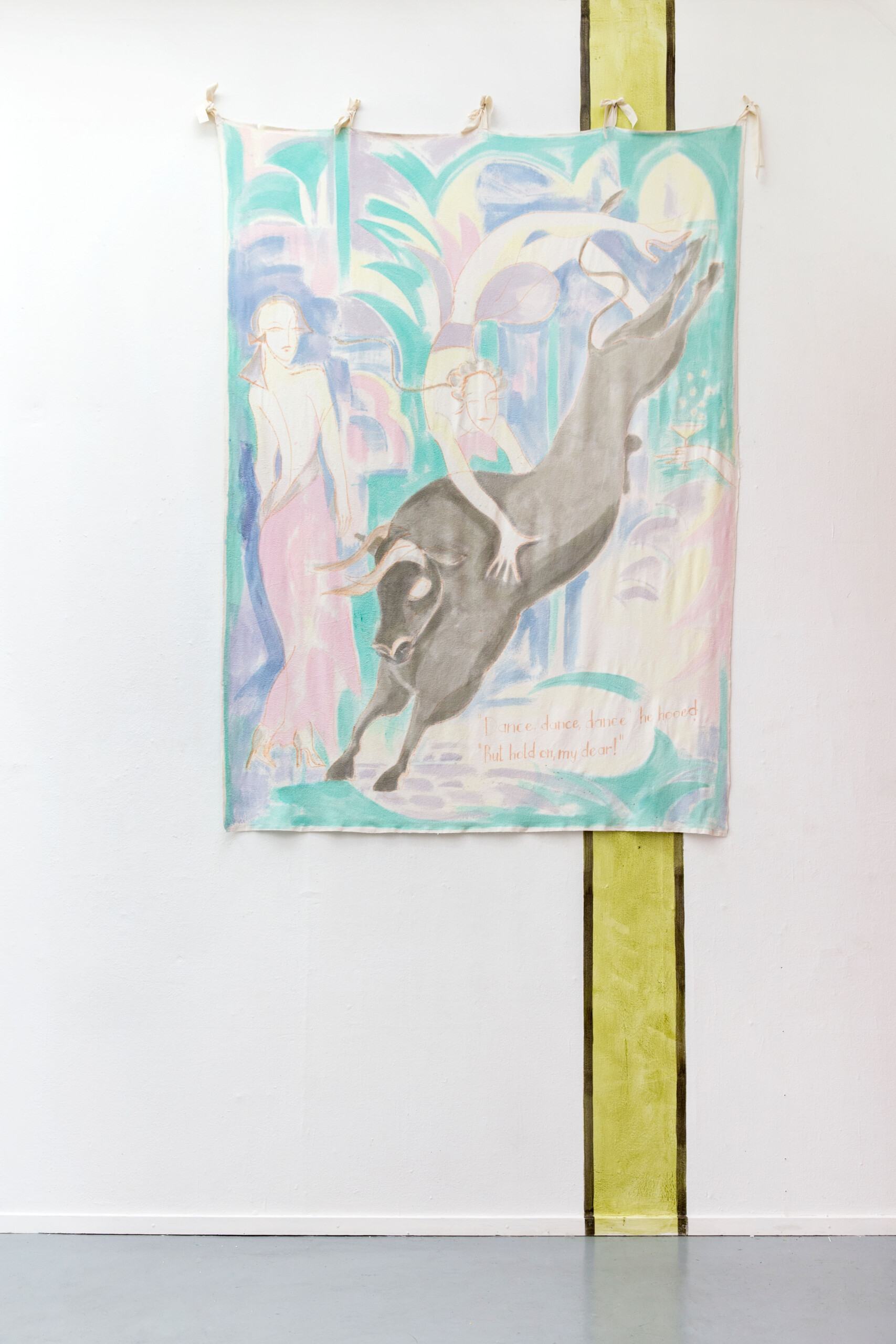
Charlott Weise, Dancing bull, 2019
acrylic on molton, 220 x 160 cm
He at Sea, 2018
Kunstfort bij Vijfhuizen, Vijfhuizen, the Netherlands
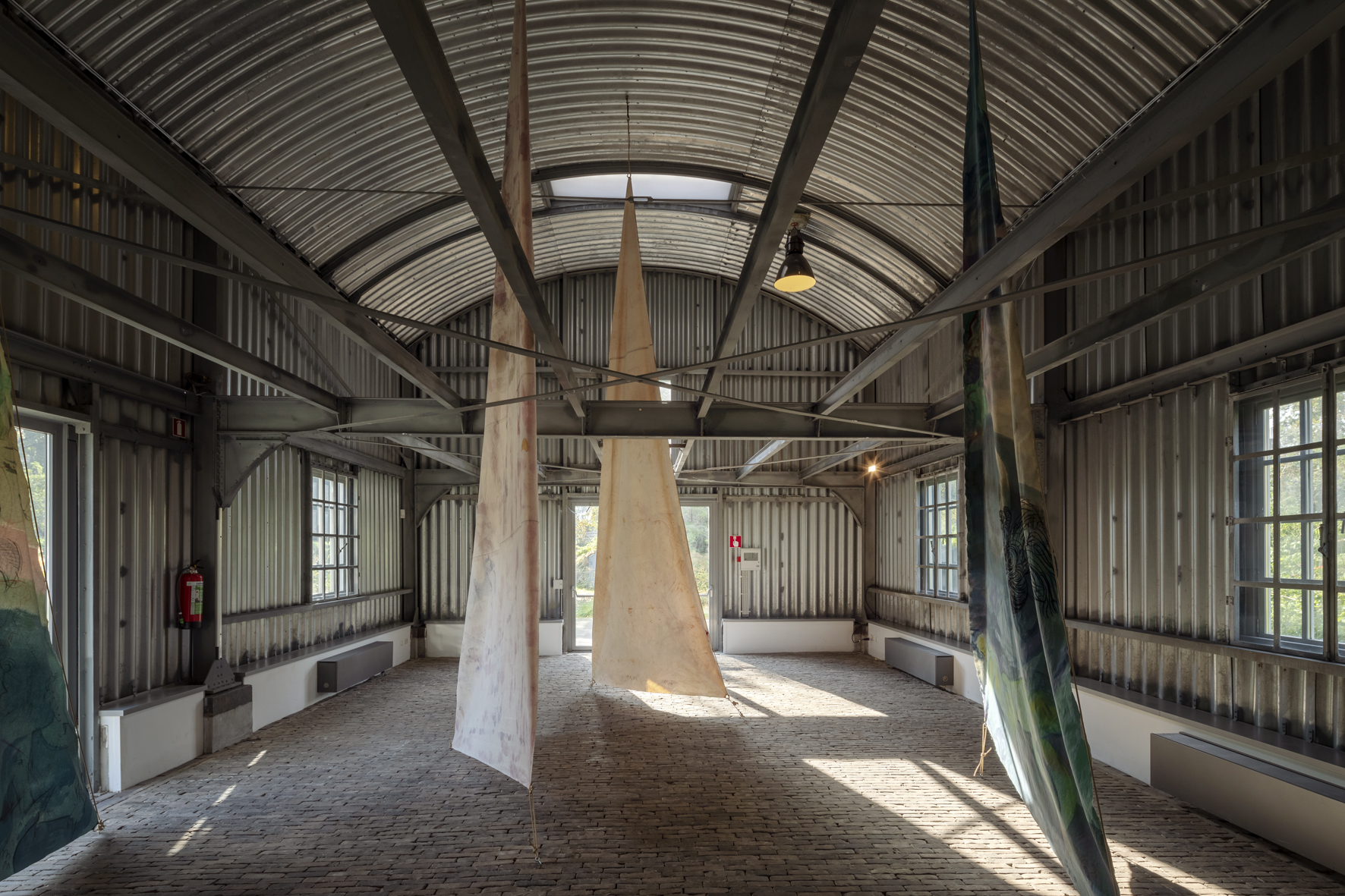
Charlott Weise, installation view, He at Sea, Kunstfort bij Vijfhuizen, 2018, Vijfhuizen (the Netherlands)
In He at Sea, Weise explores male archetypes through the figure of the sailor. In the exhibition sail paintings float in formation like ships at sea. They are suspended in the space by ropes and surround the viewer with stories of men at sea. Navigating through the emotional realm (fear, desire) in the hyper masculine realm of the sailors ship, homo-erotica currents emerge, liquifying the rigid realities (hierarchies) of life and realities back on land.
—exhibition text
Charlott Weise, installation view, He at Sea, Kunstfort bij Vijfhuizen, 2018, Vijfhuizen (the Netherlands)
Charlott Weise, installation view, He at Sea, Kunstfort bij Vijfhuizen, 2018, Vijfhuizen (the Netherlands)
Charlott Weise, installation view, He at Sea, Kunstfort bij Vijfhuizen, 2018, Vijfhuizen (the Netherlands)
Charlott Weise, installation view, He at Sea, Kunstfort bij Vijfhuizen, 2018, Vijfhuizen (the Netherlands)
Charlott Weise, installation view, He at Sea, Kunstfort bij Vijfhuizen, 2018, Vijfhuizen (the Netherlands)
Charlott Weise, installation view, He at Sea, Kunstfort bij Vijfhuizen, 2018, Vijfhuizen (the Netherlands)
Charlott Weise, installation view, He at Sea, Kunstfort bij Vijfhuizen, 2018, Vijfhuizen (the Netherlands)
Take me away, 2018
A Maior, Viseu, Portugal

Installation View
?!
I just got changed! WAIT – is there a sea of MIRRORS here?!
I have just immersed myself with… kkrrgk! My nails in TISSUE PAPER?! Kkrrgk! A brand new
BAG! – smell of strap, shine of emblem… I have just
surrounded myself with CLOUDS – Dubai! A city of PINNACLES, you SEE?
Tissue paper, little little tissue paper… you enclose myLOVELYbrandnewBAG! Kkrrgk… just got
changed with my NEW nails?! Just
immersed in liquid of myself?! Just got
changed and prepared for an inspiring woman?! Oh… NOTHING
more inspirational than an inspiring woman! How
delicious this regression… crackling little tissue paper in my possession?! Highest hotel ever?!
Softest STREAM of
screens showing me?! I have just… kkrrgk!
Tissue paper! Ribbon! Wrap me up!
—Anne Marijn Voorhorst
Charlott Weise, A MAIOR, 2019
a series of 23 hand painted posters, ink on paper
Charlott Weise, A MAIOR, 2019
a series of 23 hand painted posters, ink on paper
Charlott Weise, A MAIOR, 2019
a series of 23 hand painted posters, ink on paper
Charlott Weise, A MAIOR, 2019
a series of 23 hand painted posters, ink on paper
Potlatch, 2016
De Ateliers, Amsterdam, the Netherlands
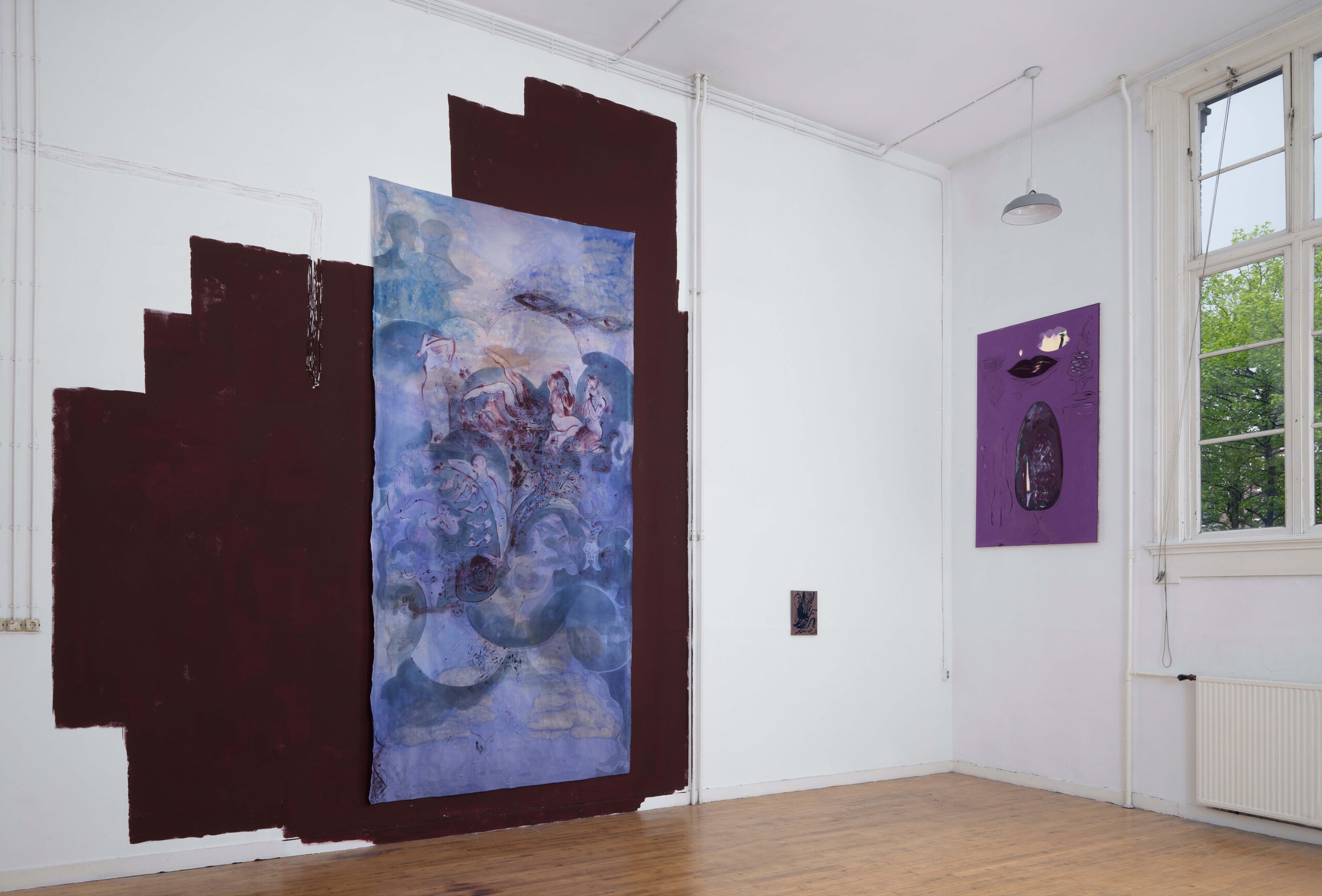
Installation View
“… Perhaps it is in the nature of accessories and their place in the larger corpus of fashion to profoundly exercise affect through the slightest accent or gesture. It’s a quality associated with the ‘minor,’ a particular register more often identified in literature but which Weise seems to exploit, whether through her concern with the writer Clarice Lispector or directly in her painting. For talk of minor is not so much about scale, Weise’s paintings are often very large, rather there’s an attention to tone or timbre, achieved through small inflections or marks whether in the shape of faintly drawn eyes that echo what might be an elegant fur cloak or the overtly sexual black painting of a nude still wearing her Manolo Blahnik’s. Whether then it’s the thickly rendered oil of a work inscribed Mama or the quietly refined figure gazing into an arabesque mirror, we are left with an acute awareness of something staged.”
—Ian Kiaer, 2016
Select drawings
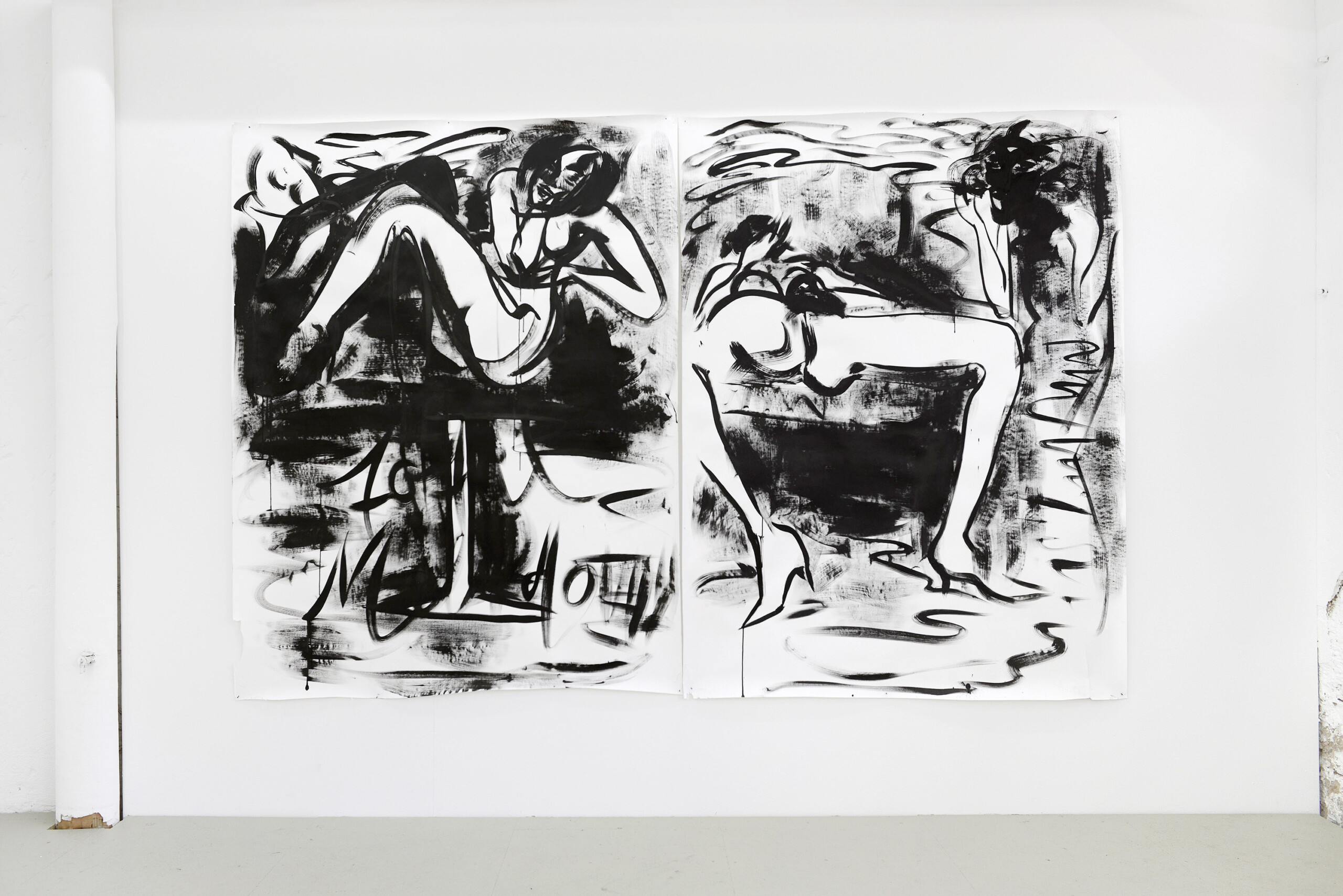
Charlott Weise, Meltdown, 2016
indian ink on paper, 195 x 300 cm

Charlott Weise, Briketterie, 2023
iron primer, ink on paper, 29.7 x 21 cm
£1,500 (ex vat)

Charlott Weise, Rußtanz, 2023
ink on paper, 29.5 x 20.5 cm
£1,500 (ex vat)

Charlott Weise, Lyssa, 2016
ink on paper, 29 x 23 cm
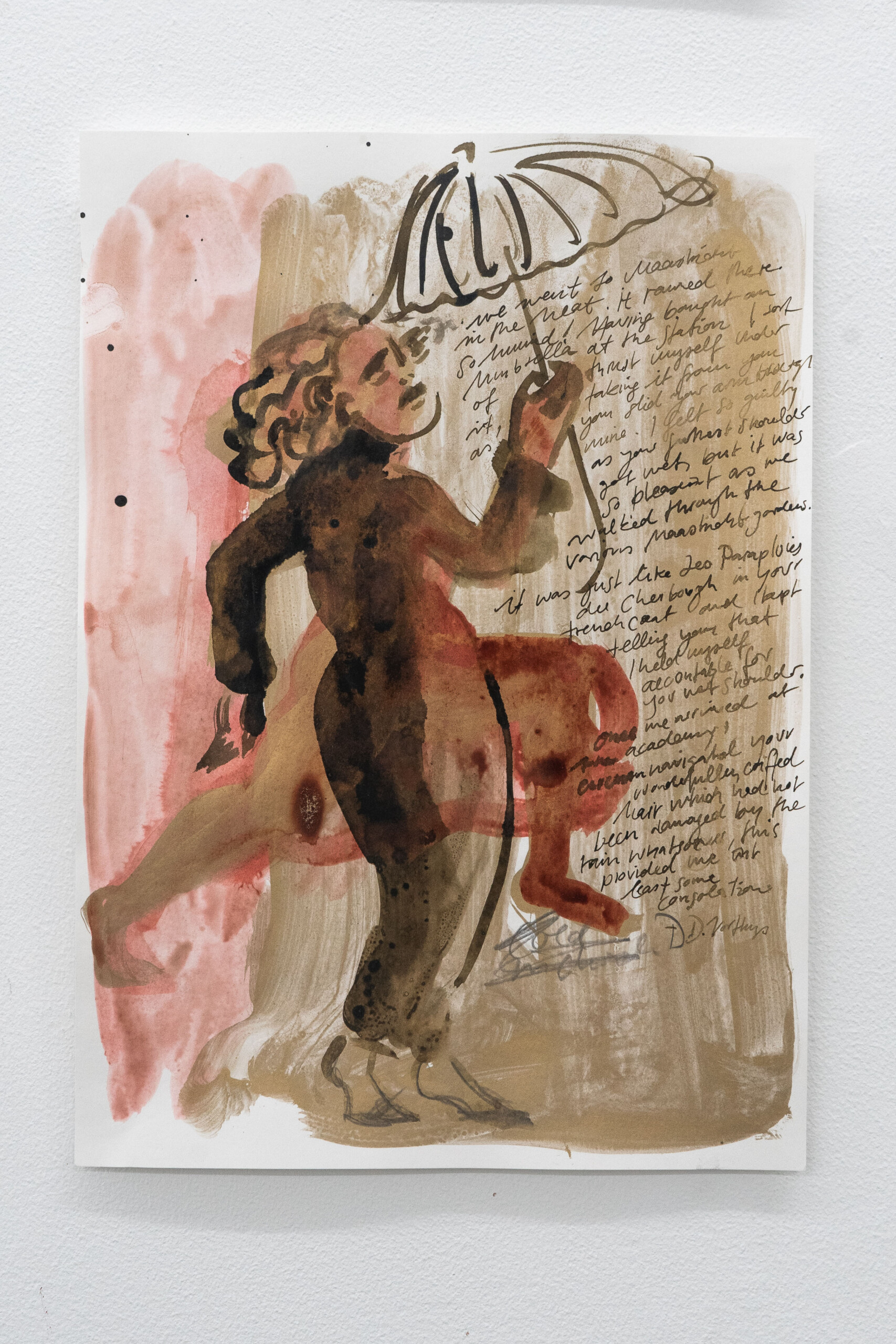
Charlott Weise, Changing to Pink, 2023
ink, pencil on paper, 29.7 x 21 cm

Charlott Weise, Love is Blind, 2019
ink on paper, 29,7 x 21 cm
Artist biography

Charlott Weise, photo by Franz Mueller Schmidt
Education. Charlott was a participant at De Ateliers (Amsterdam) in 2016. Previously, she studied at the Gerrit Rietveld Academie (Amsterdam), as well as studying under Class of Prof. Christian Macketanz, at Hochschule für Bildende Künste Dresden, and the artist Heike Dittrich, in Bautzen (Germany).
Select exhibitions. The Score, Foundation Nieuw & Meer, Amsterdam, The Neatherlands (2024); Chrome47, ArtCity, Berlin, Germany (2024); Sketches for the Furture, Belmacz at Miart 2024, Milan, Italy (2024); For these thoughts we change into pink, Belmacz, London, UK (2024); Kiss my Soul, Dordrechts Museum, Dordrecht, The Netherlands (2023); How to Cook a Wolf, two seven two gallery, Toronto, Canada (2023); Mutig Wandeln, Kunsthalle Görlitz, Germany (2023); Global Cows 2020, Images Festival, Toronto, Canada (2021); Tinted Glass, Kunsthalle Münster, Germany (2021); Notes on Wine, hosted by Cascina Gilli, NEVVEN, Castelnuovo Don Bosco, Italy (2021); Group exhibition curated by Pádraic E. Moore at Classics Museum Dublin, Ireland (2020); Koninklijke Prijs voor Vrije Schilderkunst, Koninklijke Palais Amsterdam, The Netherlands (2020); The Annotated Reader, curated by Ryan Gander & Jonathan P. Watts, Quartz Studios, Torino, Italy (2020); Vordemberge-Gildewart Award, GEM, Den Haag, The Netherlands (2020); Schulz & Weise, duo exhibition with Franziska Schulz, W139, Amsterdam, The Netherlands (2019); ampersands, W139, Amsterdam, The Netherlands (2019); Take me away, A Maior, Viseu, Portugal (2018); He at Sea, Kunstfort bij Vijfhuizen, Vijfhuizen, The Netherlands (2018); A Postcard from Amsterdam, duo, Lower.green, Norwich, UK (2018); The Ashtray Show West, Belmacz, London, UK (2018); If I was your Girlfriend, Belmacz, London, UK (2018); The Yellow Wallpaper, Ginerva Gambino, Cologne, Germany (2017); Johnny Suede, Damien & the Love Guru, Brussels, Belgium (2017); CILADA, A Maior, Viseu, Portugal (2017); 9 PAINTINGS, Galería Formatocomodo, Madrid, Spain (2016); NADA Miami Beach, Galería FORMATOCOMODO, USA (2016); Whiskers by the name of lilacs, Galerie Rianne Groen, Rotterdam, The Netherlands (2016);PAAREN, PS projectspace, Amsterdam, The Netherlands (2015); SELECTED, Castrum Peregrini, Amsterdam, The Netherlands (2014); Entering the Painting, tegenboschvanvreden, Amsterdam, The Netherlands (2014).
Awards and grants. Artist Grant of the Mondriaan Fund (2022); Winner Koninklijke Prijs voor Vrije Schilderkunst (2020); Nominated for Vordemberge-Gildewart Award (2020); Artist Start Grant of the Mondriaan Fund (2017); Praktijkverdieping Postacademische Instellingen Grant of the Mondriaan Fund (2014-2016); Nominated for Rietveld Academie Award (2014); Nominated for Rietveld Fine Arts Prize (2014); 2. Prize E.O. Plauen Junior Award (2012).
Alongside her individual practice, Charlott is also a member of Cold in Church, a band of performative artists based in Amsterdam. Recent performances include: IF—A MUSICAL WITH POP MUSIC, NOISE, AND MANY THEATRICAL ASIDES, Rijksakademie van beeldende kunsten, Amsterdam The Netherlands (2023); and Hot Mesh, Rijksakademie van beeldende kunsten, Amsterdam, The Netherlands (2022).
Charlott lives and works between Amsterdam (The Netherlands) and Görlitz (Germany).
Enquiries
Please contact us directly gallery@belmacz.com with any enquiries. Please note that all works are subject to prior sales and tax where applicable
